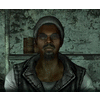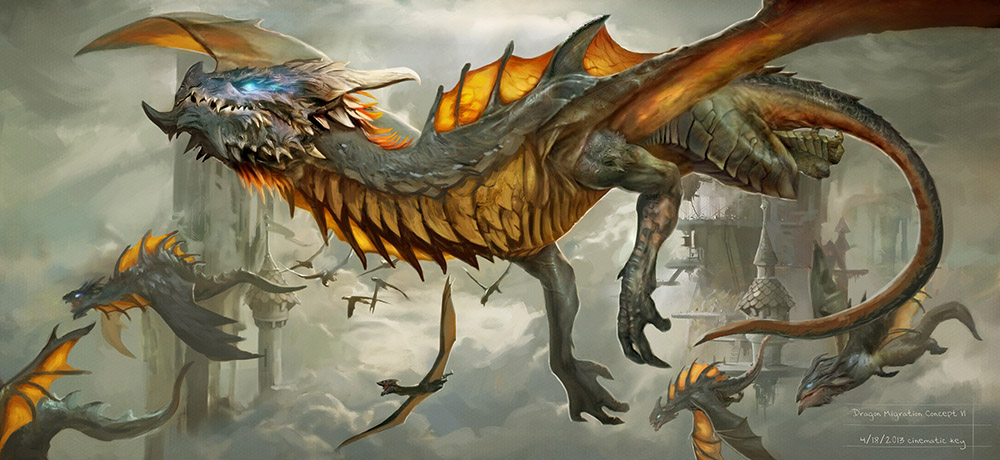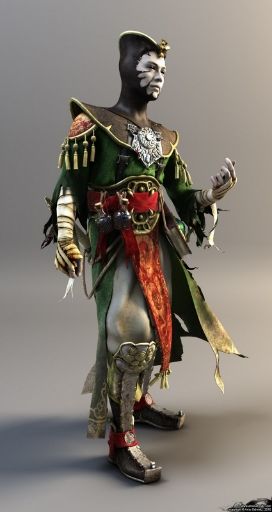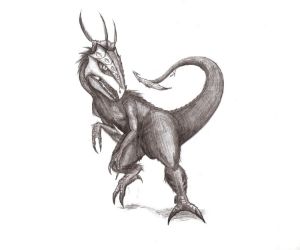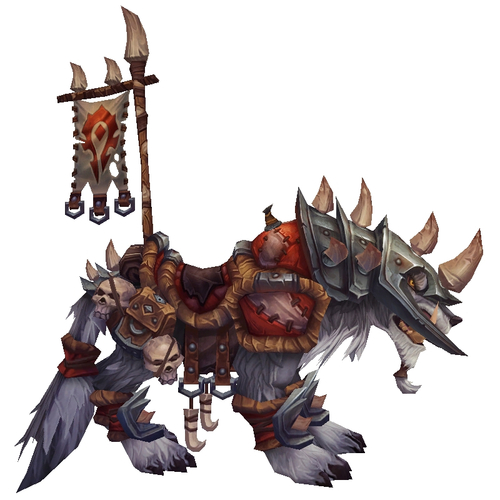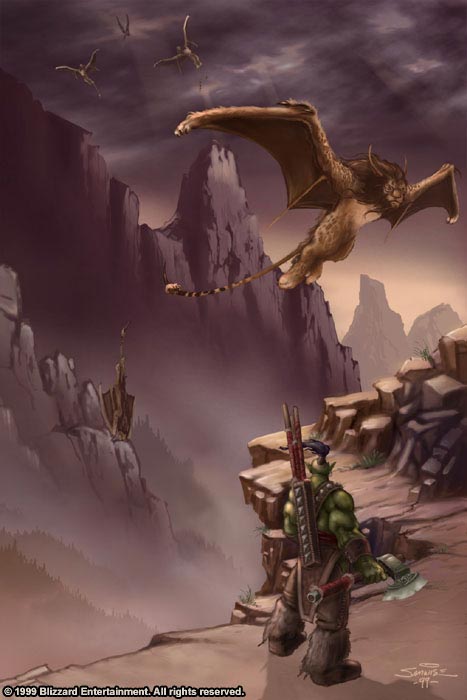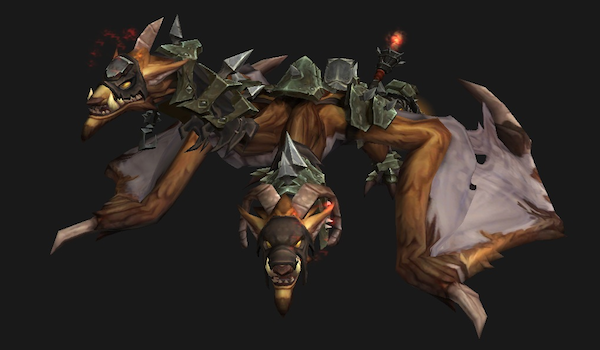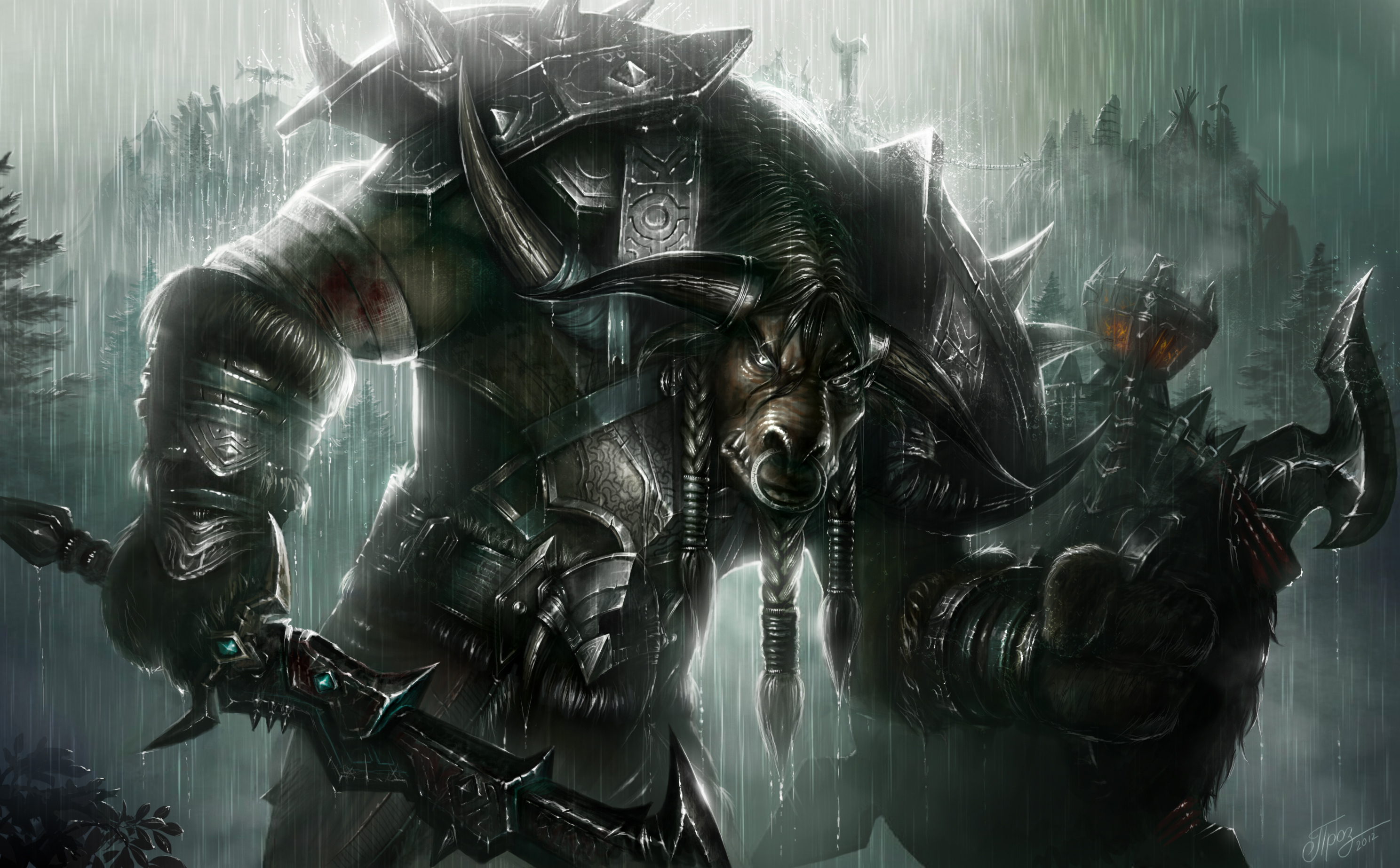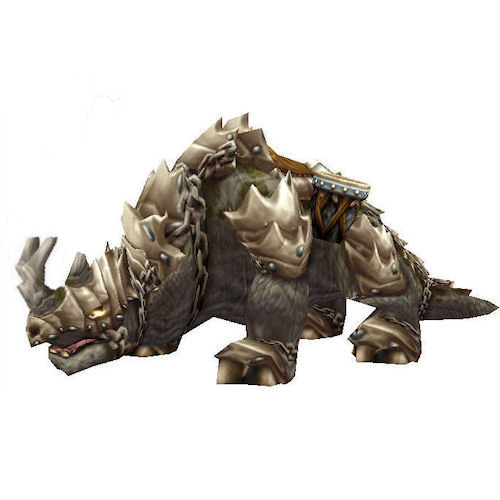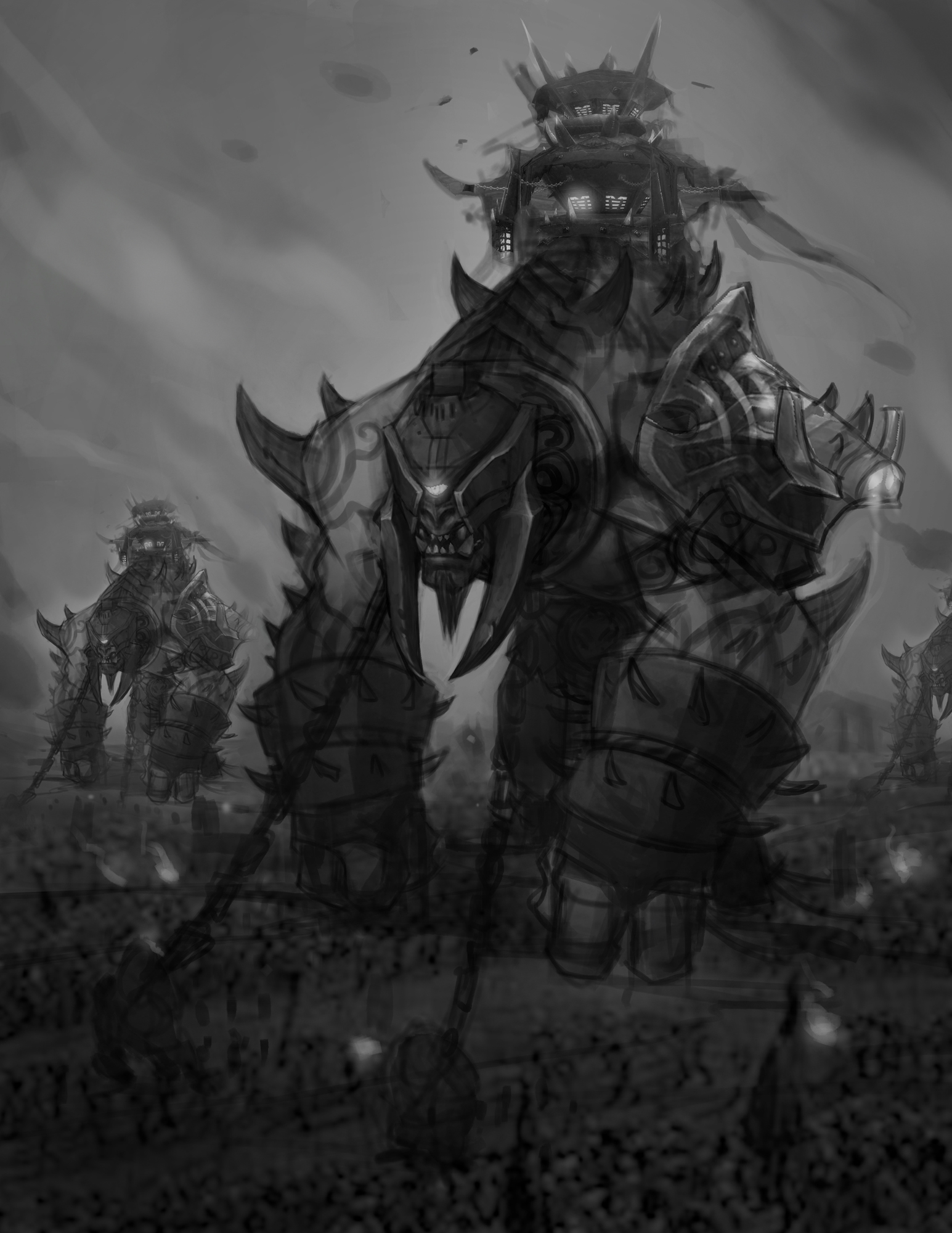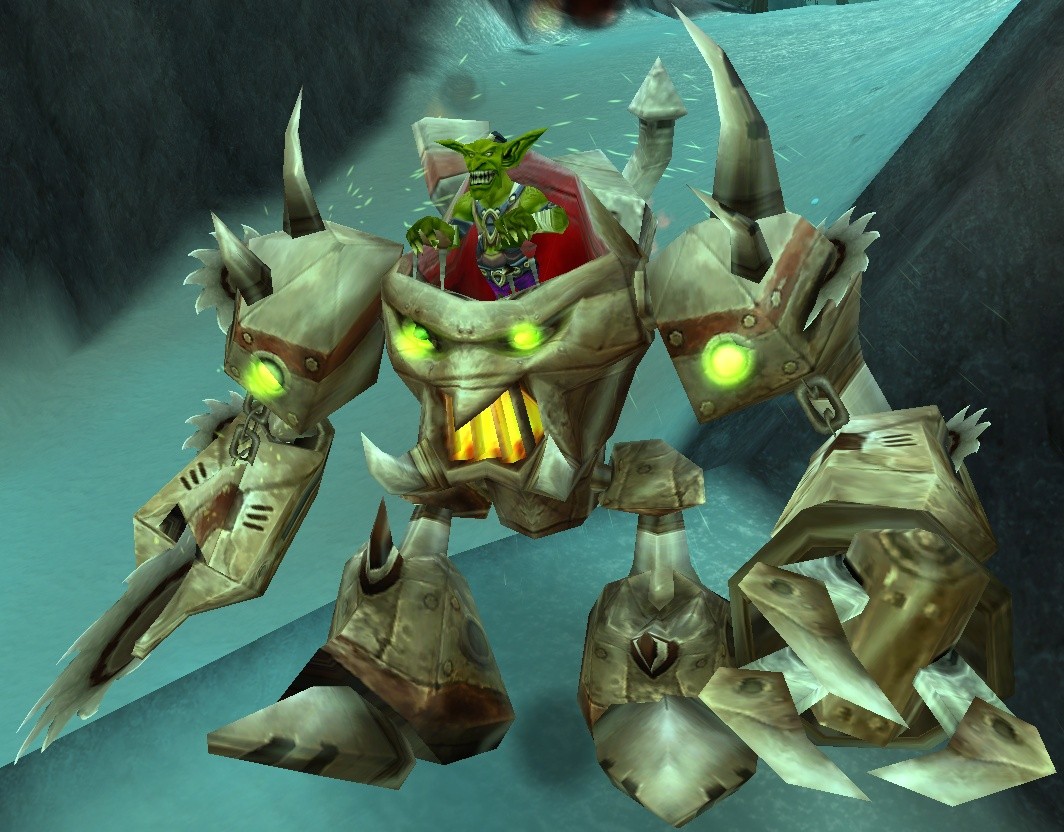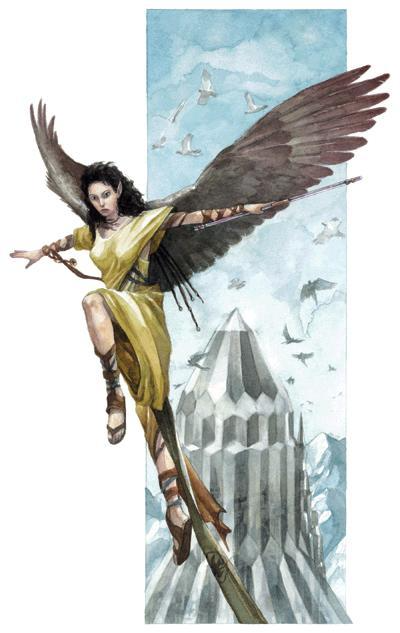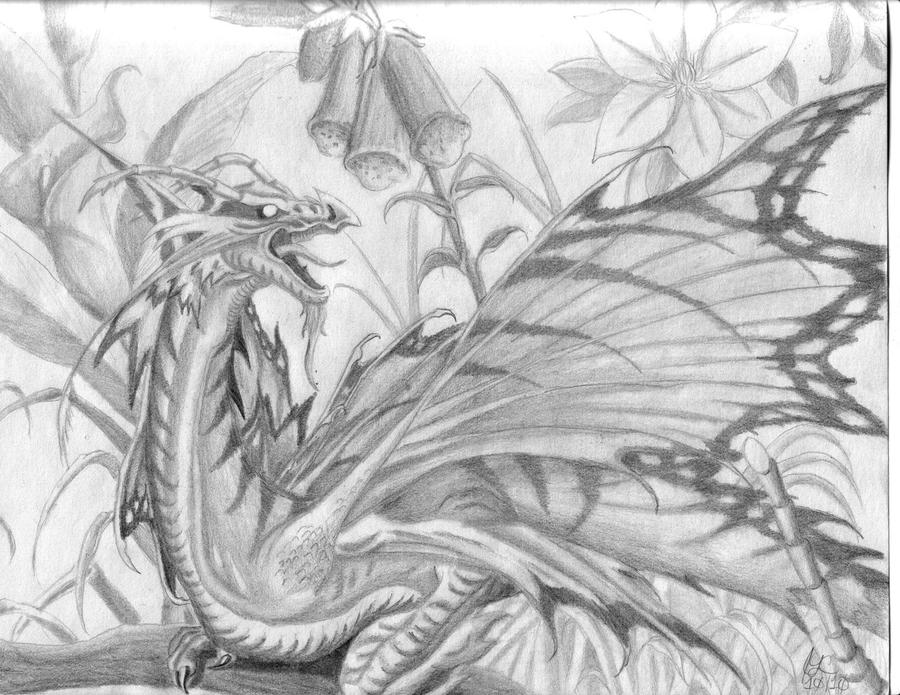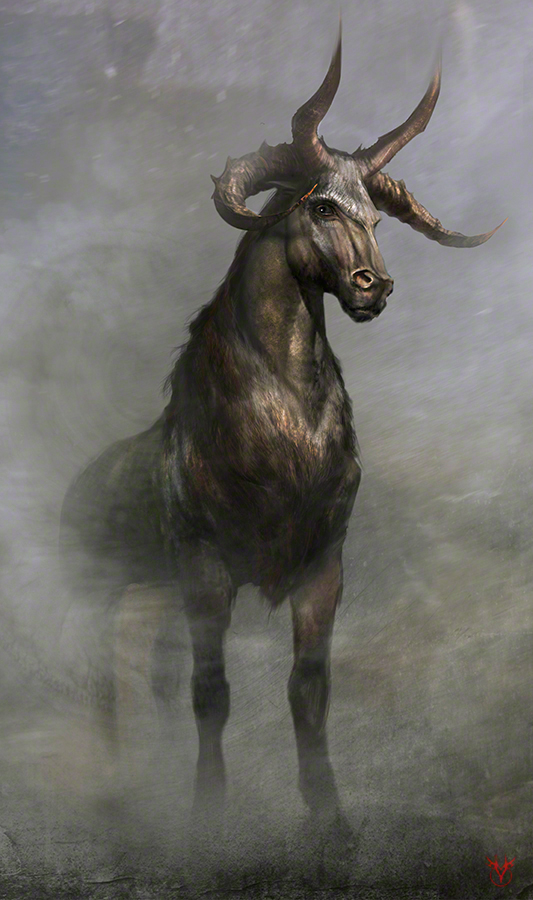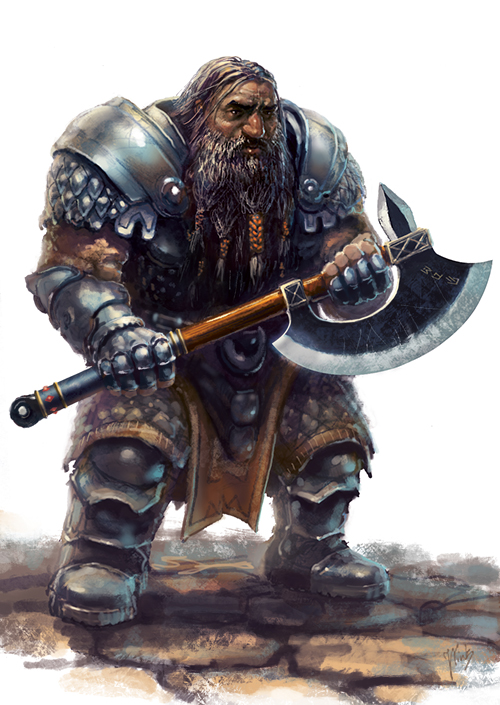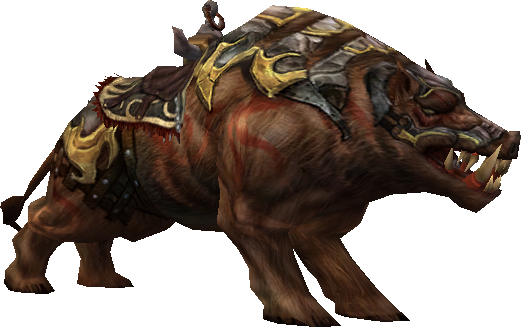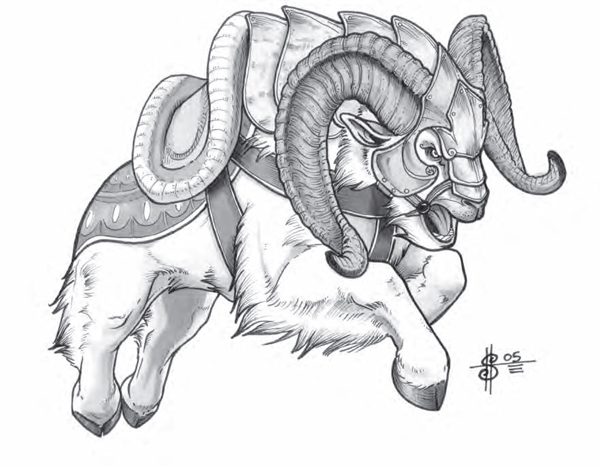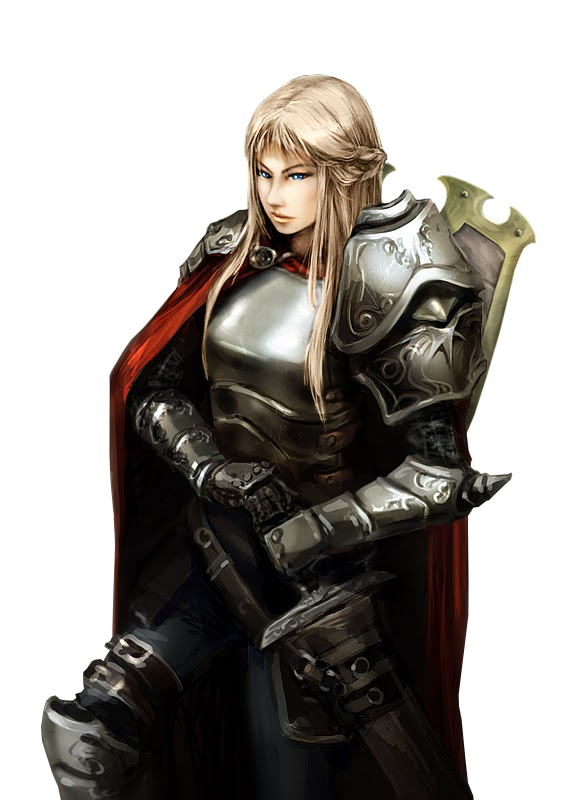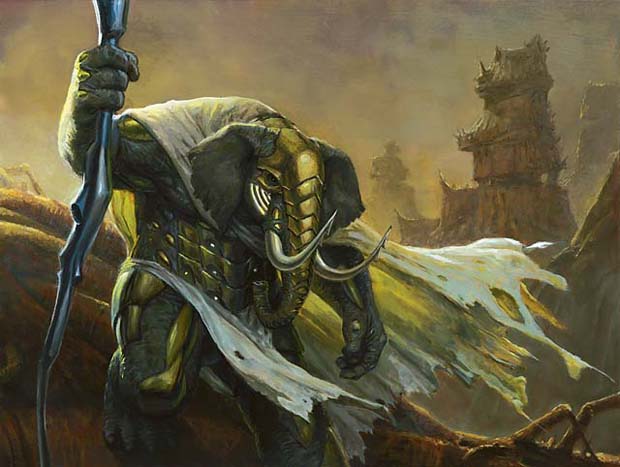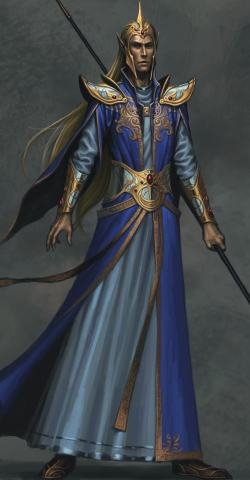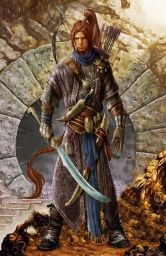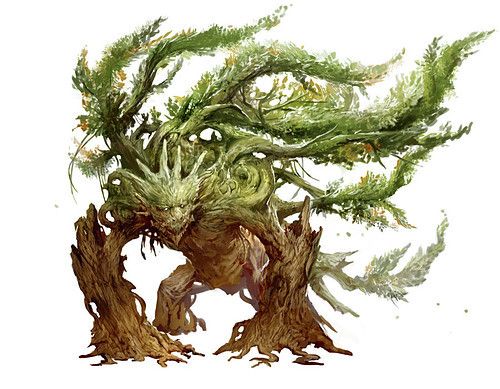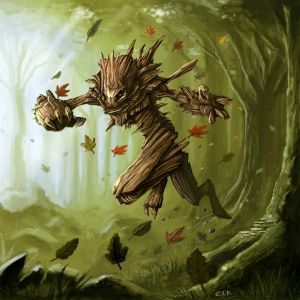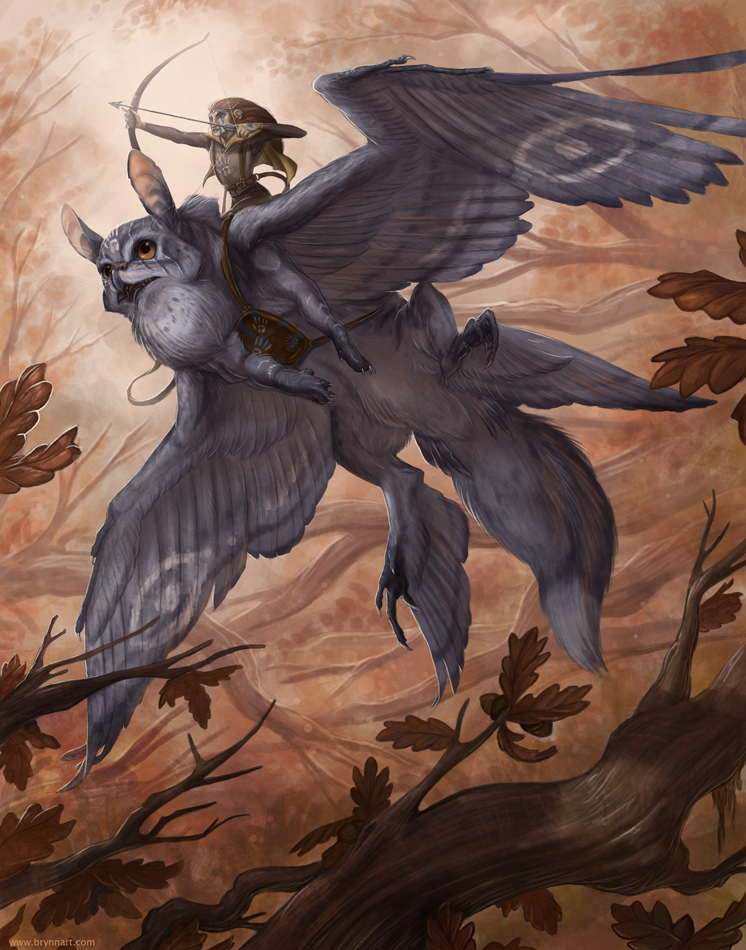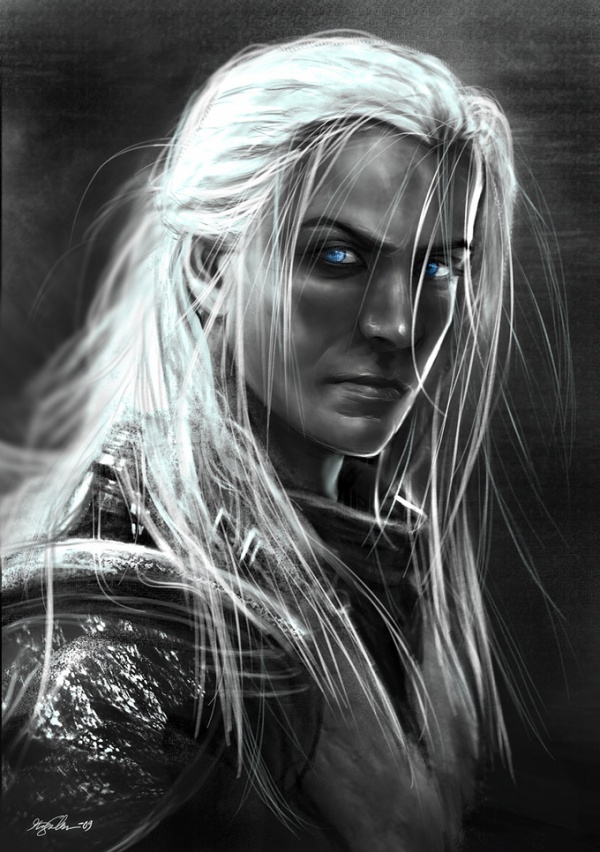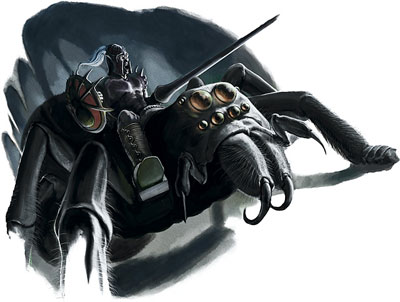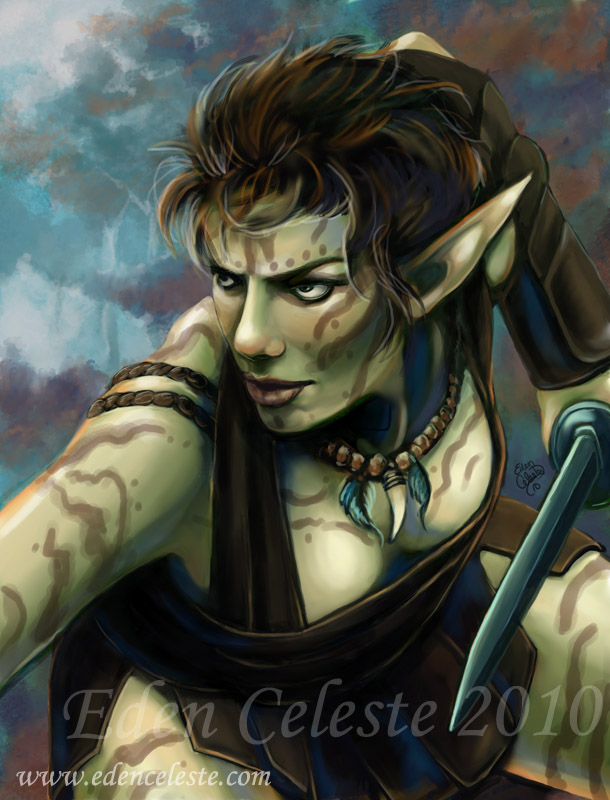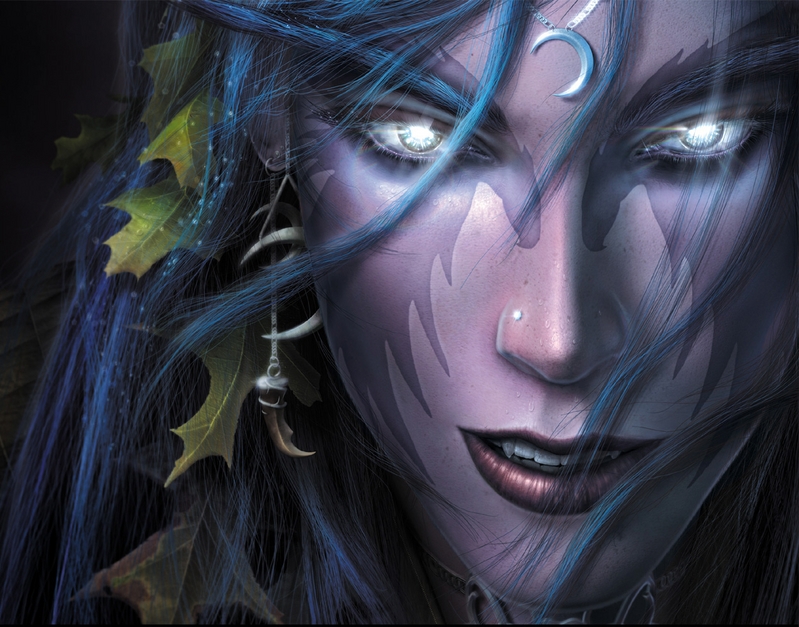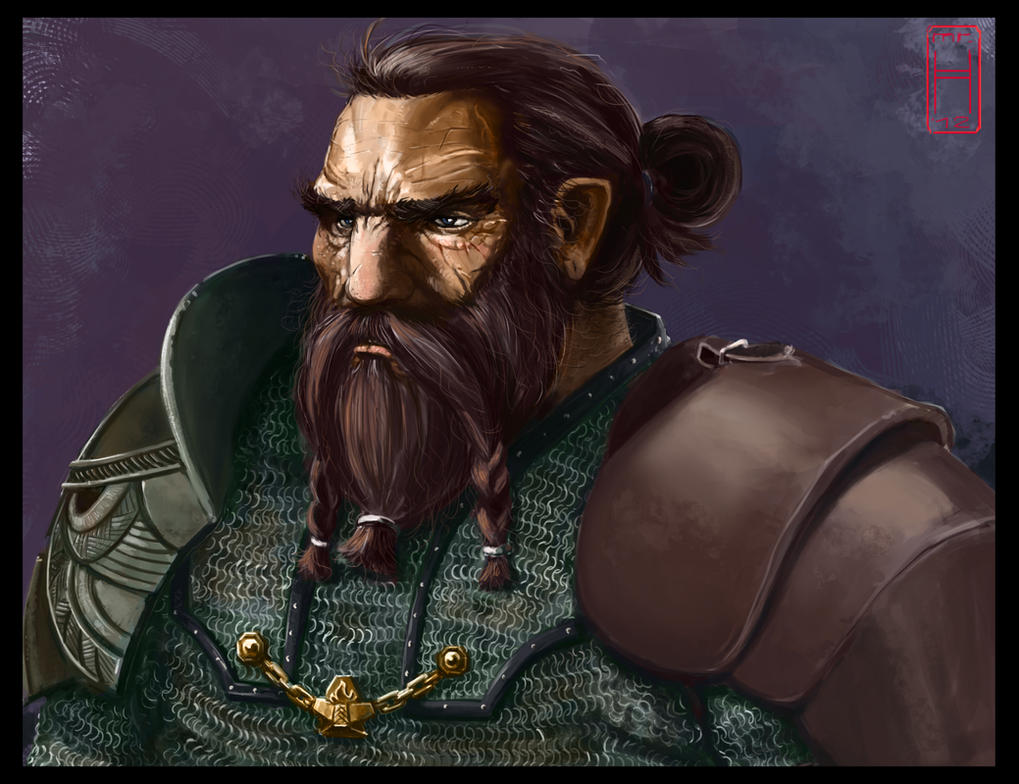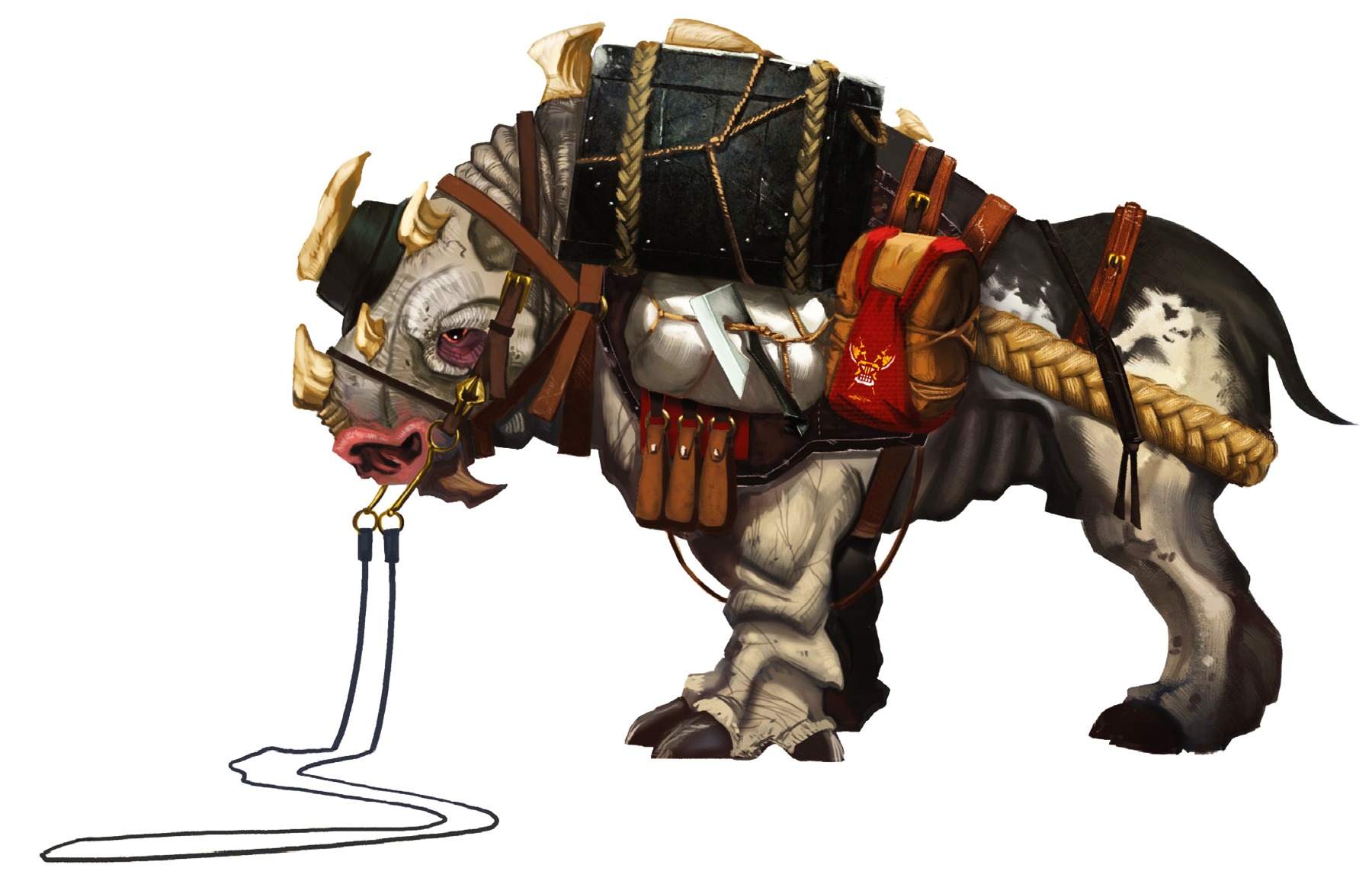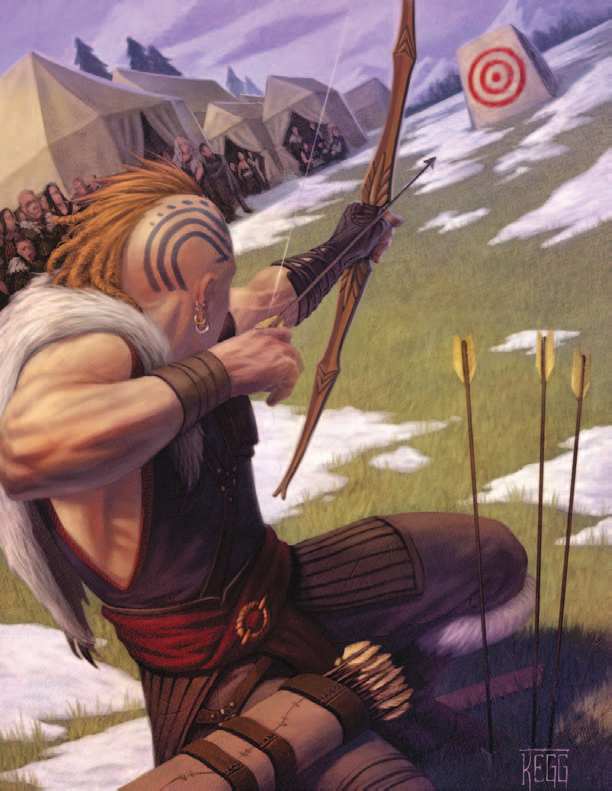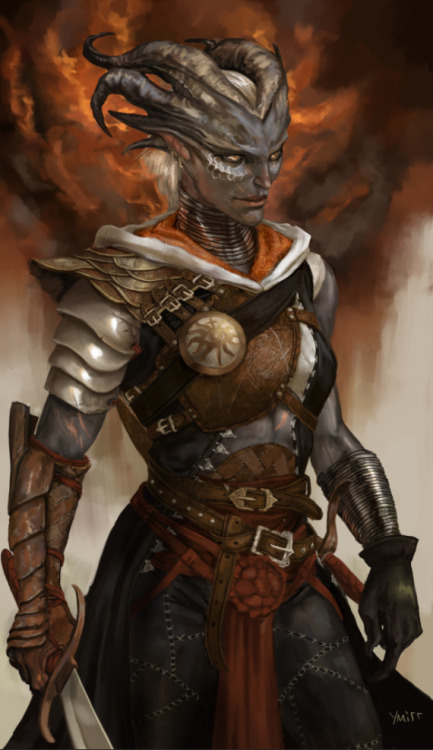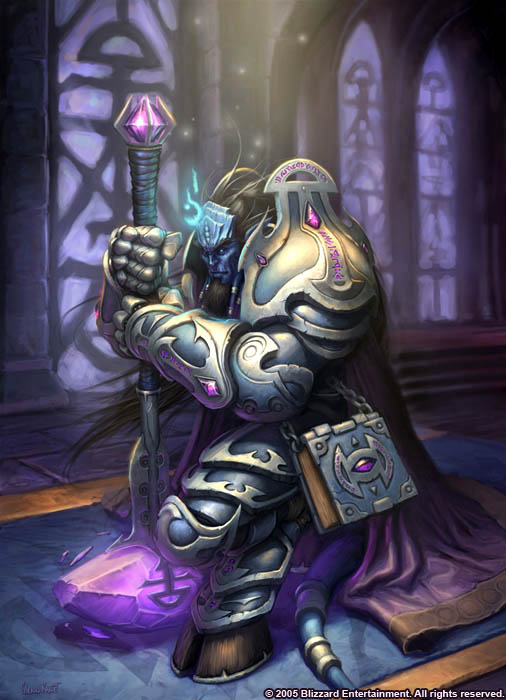Intelligent Species and Ethnic Groups of Gabriola. [WIP]
May 11, 2015 12:06:26 GMT -5
via the ProBoards App
Post by ThreeDawg on May 11, 2015 12:06:26 GMT -5
Native To The Northlands:
{Svarjholders: - Click to View}

Species: Human,
Ethnicity: Svarjholder (or Svarjer),
Native to: Distant Lands Across The Oceans (so long ago even cultural memory has forgotten), Now the Northlands,
Found Primarily: Svarjhold, Freeholds of Aleksland, Gortland and other Svarjholder colonies, The North.
Globalised: Heavy, extensive Svarjholder presence as oceanic raiders and traders including small colony in the Hordelands
"There's no group of men that have traveled as far as the Svarjers, they say a Svarjer once sailed right around Gabriola! Can you imagine the pillage he must've brought back? - A Merchant From Thurunn.
The Kingdom of Svarjhold was established by King Urik, the current rulers Grandfather. Urik was a mighty raider and chieftain who convinced a large amount of the local chieftains of the region to support his bid for ruler ship, the others were swiftly brought to heel at spear point after years of conflict in the region. These days were known as 'The Days of Red Snow' due to the blood spilled. Uriks son, Olaf Uriksson expanded the kingdom eastword, establishing a few free-holds and trading posts. The people of Svarjhold consider themselves loosely related to the Atannarians, and have a general 'non-aggression' pact with them, choosing to trade and interact with them over conquest and raiding. This does not stop members from the warrior societies from engaging in the occasional brawl over minor insults and disputes. The current ruler of the warriors of Svarjhold is Harld Olafsson. He has continued the traditions of his ancestors, leading multiple raids himself to prove himself to the various chieftains.
Social structure is as follows:
Chieftains
Storytellers
Warriors
Traders
Thralls (slaves)
Mount of choice:

Species: Human,
Ethnicity: Svarjholder (or Svarjer),
Native to: Distant Lands Across The Oceans (so long ago even cultural memory has forgotten), Now the Northlands,
Found Primarily: Svarjhold, Freeholds of Aleksland, Gortland and other Svarjholder colonies, The North.
Globalised: Heavy, extensive Svarjholder presence as oceanic raiders and traders including small colony in the Hordelands
"There's no group of men that have traveled as far as the Svarjers, they say a Svarjer once sailed right around Gabriola! Can you imagine the pillage he must've brought back? - A Merchant From Thurunn.
The Kingdom of Svarjhold was established by King Urik, the current rulers Grandfather. Urik was a mighty raider and chieftain who convinced a large amount of the local chieftains of the region to support his bid for ruler ship, the others were swiftly brought to heel at spear point after years of conflict in the region. These days were known as 'The Days of Red Snow' due to the blood spilled. Uriks son, Olaf Uriksson expanded the kingdom eastword, establishing a few free-holds and trading posts. The people of Svarjhold consider themselves loosely related to the Atannarians, and have a general 'non-aggression' pact with them, choosing to trade and interact with them over conquest and raiding. This does not stop members from the warrior societies from engaging in the occasional brawl over minor insults and disputes. The current ruler of the warriors of Svarjhold is Harld Olafsson. He has continued the traditions of his ancestors, leading multiple raids himself to prove himself to the various chieftains.
Social structure is as follows:
Chieftains
Storytellers
Warriors
Traders
Thralls (slaves)
Mount of choice:
{Half-Orcs: - Click to View}
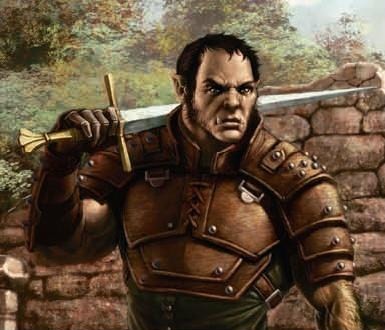
Species: Human-Orc Crossbreed,
Ethnicity: Primarily Svarjer Human or Galar Orc,
Native to: The North (Largely), The Hordelands (Largely),
Found Primarily: Where Svarjholders and Orcs mix, Svarjhold, Hordelands,
Globalisation: Minor, the offspring of Humans and Orcs can be found in small numbers on Svarjer ships or working for The Horde, non-Svarjer Half-Orcs are very rare and reviled by their Human-side Culture.
"There's honour in being a strong Half-Orc! But stay close to friends, the Fontèans won't see anything but the tusks in your mouth and the point to your ears!" - A Svarjer Captain to his new Half-Orc crewman.
While not a new species, Half-Orcs were exceptionally rare until late. Communication between Orcs and Humans has rarely been good, let alone capable of producing children. As such there was but a handful of Half-Orcs born per decade, most of which were oft killed at birth or soon after by either their mother or their local communities.
Yet now there are hundreds, with many more being born every year. This is largely due to the recent 'discovery' of the Hordelands by the Svarjmen. As such, most Half-Orcs are no older than thirty years of age and are either raised amongst Svarjholders or amongst Galar Orcs.
They mix many of the features of Orcs and Humans, being less muscular than Orcs yet more so than Humans. They are no taller than Humans, and have pale-brown, almost beige, skin. Their ears are slightly pointed, their fangs slightly larger than your standard Humans and their dentition includes a set of small tusks held hidden behind their lips. Peculiarly their hair colour is often determined by the Human of the coupling, while their eye colour is determined by the Orc. It can be noted that an Orc tainted by the Arcane, it's skin a fetid Green, will pass this trait onto the Half-Orc. This Half-Orc will continue to carry the stigma of its parent in Orc society. The Children of Half-Orcs carry even less of the admixture, leaning more towards Human or Orc dependant on which species is their partner. A Half-Orc and a Half-Orc will produce another offspring of clearly mixed blood.
Half-Orcs have no society, no culture. They are strangers in their birth lands. The response of their parent races varies wildly, more Orthodox Orcs refuse to acknowledge Half-Orcs even going so far as to persecute them as they do any Half-Ogre offspring - the offspring of Humans are about as welcome as Humans. Forward-thinking Orcs see Half-Orcs as a sign of a good future, where their conflict with Humanity can be put to rest, the current Warchief is one of these Orcs.
There is a similar response in Svarjhold, although they tend to be better treated. As such Half-Orcs are more common in Svarjhold than the Hordelands, and one group has even gone as far as to emulate a clan-like existence in the North loyal to the Svarjer King.
Half-Orcs are reviled as much as an Orc in other Human lands.
Mount of choice: Half-Orcs have no mount of choice, but will rather ride what mount is available to them by their birth culture.

Species: Human-Orc Crossbreed,
Ethnicity: Primarily Svarjer Human or Galar Orc,
Native to: The North (Largely), The Hordelands (Largely),
Found Primarily: Where Svarjholders and Orcs mix, Svarjhold, Hordelands,
Globalisation: Minor, the offspring of Humans and Orcs can be found in small numbers on Svarjer ships or working for The Horde, non-Svarjer Half-Orcs are very rare and reviled by their Human-side Culture.
"There's honour in being a strong Half-Orc! But stay close to friends, the Fontèans won't see anything but the tusks in your mouth and the point to your ears!" - A Svarjer Captain to his new Half-Orc crewman.
While not a new species, Half-Orcs were exceptionally rare until late. Communication between Orcs and Humans has rarely been good, let alone capable of producing children. As such there was but a handful of Half-Orcs born per decade, most of which were oft killed at birth or soon after by either their mother or their local communities.
Yet now there are hundreds, with many more being born every year. This is largely due to the recent 'discovery' of the Hordelands by the Svarjmen. As such, most Half-Orcs are no older than thirty years of age and are either raised amongst Svarjholders or amongst Galar Orcs.
They mix many of the features of Orcs and Humans, being less muscular than Orcs yet more so than Humans. They are no taller than Humans, and have pale-brown, almost beige, skin. Their ears are slightly pointed, their fangs slightly larger than your standard Humans and their dentition includes a set of small tusks held hidden behind their lips. Peculiarly their hair colour is often determined by the Human of the coupling, while their eye colour is determined by the Orc. It can be noted that an Orc tainted by the Arcane, it's skin a fetid Green, will pass this trait onto the Half-Orc. This Half-Orc will continue to carry the stigma of its parent in Orc society. The Children of Half-Orcs carry even less of the admixture, leaning more towards Human or Orc dependant on which species is their partner. A Half-Orc and a Half-Orc will produce another offspring of clearly mixed blood.
Half-Orcs have no society, no culture. They are strangers in their birth lands. The response of their parent races varies wildly, more Orthodox Orcs refuse to acknowledge Half-Orcs even going so far as to persecute them as they do any Half-Ogre offspring - the offspring of Humans are about as welcome as Humans. Forward-thinking Orcs see Half-Orcs as a sign of a good future, where their conflict with Humanity can be put to rest, the current Warchief is one of these Orcs.
There is a similar response in Svarjhold, although they tend to be better treated. As such Half-Orcs are more common in Svarjhold than the Hordelands, and one group has even gone as far as to emulate a clan-like existence in the North loyal to the Svarjer King.
Half-Orcs are reviled as much as an Orc in other Human lands.
Mount of choice: Half-Orcs have no mount of choice, but will rather ride what mount is available to them by their birth culture.
{Aotelli: - Click to View}

Species: Aotelli,
Ethnicity: Aotelli,
Native to: The North originally,
Found Primarily: Now restricted to the Island of Gortland,
Globalisation: None, very few Aotelli make it off their island home - and usually only as prisoners or caged curiosities on Svarjer ships.
"They brought Carfson back on a boat... Dead, his ma' weeped for days. Should've seen the state of him, all clawed up you could hardly tell what was what. They say one of those feathered snow-demons in Gortland did him in..." - A Mainland Svarjer.
Aotelli are an Avian Bipedal species. They are flightless, although they retain relatively hollow bone structure and feathers that give them some glide during a fall. They are quick, strong, but as many Svarjholders know: easily broken. They are beakless, instead having a lipped mouth and a nose, yet they retain the angular facial structure of other avian species. All individuals have facial crests of various shape and colours. These crests all taper up and backwards, giving their faces a tall and thin appearance. They can be built similarly, or be short and stocky - they run a similar height and body morphology to Humans.
They are a cold-weather species, with thick feather coats and dense muscle underneath. Their feet are four taloned, three to the front and one to the back. Their hands are equally digited, although the talons are far shorter and the fourth digit is smaller and more easily manipulated. Feather colours range from Browns to creams, blacks to whites and are often speckled, flaked or 'dipped' in a secondary colour (it isn't unheard of for the ribs of each feather to be a secondary colour to the primary). Iris colour is usually black, although rarely will one be blue or purple.
-----
Existing outside the bounds of Svarjholder society are the Aotelli. Native to their large island home, the Aotelli are an apparently primitive avian 'Beast Race' that existed long before the coming of Man to their island. At one point in time their civilisation was advanced enough to have irrigated crops, grand temples and vast cities disproportional to cultures of the time in the North. Their civilisation has taken a dramatic reduction, either as a result of Human colonisation or changing climates in the North. Now all that exists are semi-nomadic hunter-gatherer tribes flitting about the edges of their once grand domain and avoiding contact with Humanity. They are best left undisturbed.
Aotelli society is matrilineal, females of the species are stronger and arguably more intelligent. However the females rarely venture out of camp, instead focusing on rearing offspring, inter-tribe politics and warfare. Males are far more populous and make up the hunters, gatherers and communal workers. In times of strife, males will be corralled into using their hunting and survival skills to perform guerrilla warfare.
There are over a dozen tribes throughout the island. Although there are four of particular prominence. Each of these four tribes are characterised by the colour of their feathers, a lineage that has been bred into them since their ancient kingdoms. The smaller tribes are an intermediate of the four tribes, perhaps due to recent mixes of tribal exiles. Or representing lower castes of the ancient civilisation.
The four main Tribes are the Aselidae, Tayakae, Gurapjie and the Fuaanja.
The Aseli are known as the "Mountain Harpies" by the Svarjholders, due to their year-round dark plumage and control over the island's northern mountain range. Of the all Aotelli tribes they are the most powerful, and least untouched by war. They maintain rulers hip over several ruins in the mountain's depths.
The Taya, or "Snow Daemons", are an Aotelli tribe that rules over the wastes of the north-west. Their plumage is silver or 'platinum' with often stark black tips. Of the four main tribes they host the most renowned hunters, who will go days, often weeks, in pursuit of large prey. Barely surviving on what they take with them or can scratch from beneath the ice layer until a kill is made.
The Gura stand out from the other tribes by living in wooded areas. Specifically the isolated North-Eastern "Forest of Songs". They are brown feathered, with flecks of white or black throughout. They give the forest it's name by their shrill songs of war during combat or hunting.
The Fuaan, the final and smallest of the four major tribes, used to be the most powerful. They rule over stretches of coastline in the West, and are at near constant odds with the Svarjholders. Their feathers range from a browned gold to sandy cream. They are exceptional swimmers, and actually make most of their kills on large sea mammals in the area.
Aotelli Hunters are particularly skilled in the use of the bow, due to their sharp eyesight. They craft highly efficient yet unappealing bows out of local wood, animal sinews and often marine mammal tusks or teeth. Spears are also a favoured weapon, to which they maintain as a sacred art. Each family will craft themselves a ceremonial spear, intricately carved with animals an figures that tell the story of their family. Too many of these spears involve Humans and warfare. These "House Spears" are rarely used as weapons, but the main figurehead, or "crest" on the aft is copied onto each spear crafted by the Aotelli of that family. While most spears are wooden with metalled ends, exceptional hunters have been known to craft Ivory spearheads or a warrior to gather enough metal to fashion a pure spear. A metal spear is a bold statement to the Aotelli - I have killed and I will kill again.
Aotelli do wear clothing, although their feathers are thick enough to keep them warm. Males will wear cloth rags around their legs, like a loose kilt, potentially with a bandolier to hold items. Females will also wear this bandolier, but are often more heavily clothed in robes or toga-like dresses. They will also carry infants with them (a status symbol), rarely will one carry around a hatchling, but never an egg. Instead eggs are raised communally by the most influential members of each family in a tribe. Females are taken away young to be raised by their mother's family, while males are kept to be communally raised.
When actively going to war, Aotelli or both sexes will don studded leather leg guards, breast plates, shoulder pads and arm guards. Few if any will wear helmets, and even fewer still will wear full metal pieces.
Religiously, the Aotelli follow a triumvirate or nature Gods. These powerful spirits were said to have rose their island home from the oceans floor, the Aotelli coming here from the mainland long ago. There are no Aotelli on the continent, and it's unclear if there ever was. The Gods are as follows:
Mathem, the goddess of Soils, sculpted as an Aotelli carrying a basket of fruits.
Frajaa'la, the goddess of the Wilds, sculpted as a Stag with the upper body of an Aotelli.
Sesaitu, the Goddess of Bones, sculpted as a Winged Wolf.
Mount of choice: The Aotelli have never known a mount, although feasibly they could ride any.

Species: Aotelli,
Ethnicity: Aotelli,
Native to: The North originally,
Found Primarily: Now restricted to the Island of Gortland,
Globalisation: None, very few Aotelli make it off their island home - and usually only as prisoners or caged curiosities on Svarjer ships.
"They brought Carfson back on a boat... Dead, his ma' weeped for days. Should've seen the state of him, all clawed up you could hardly tell what was what. They say one of those feathered snow-demons in Gortland did him in..." - A Mainland Svarjer.
Aotelli are an Avian Bipedal species. They are flightless, although they retain relatively hollow bone structure and feathers that give them some glide during a fall. They are quick, strong, but as many Svarjholders know: easily broken. They are beakless, instead having a lipped mouth and a nose, yet they retain the angular facial structure of other avian species. All individuals have facial crests of various shape and colours. These crests all taper up and backwards, giving their faces a tall and thin appearance. They can be built similarly, or be short and stocky - they run a similar height and body morphology to Humans.
They are a cold-weather species, with thick feather coats and dense muscle underneath. Their feet are four taloned, three to the front and one to the back. Their hands are equally digited, although the talons are far shorter and the fourth digit is smaller and more easily manipulated. Feather colours range from Browns to creams, blacks to whites and are often speckled, flaked or 'dipped' in a secondary colour (it isn't unheard of for the ribs of each feather to be a secondary colour to the primary). Iris colour is usually black, although rarely will one be blue or purple.
-----
Existing outside the bounds of Svarjholder society are the Aotelli. Native to their large island home, the Aotelli are an apparently primitive avian 'Beast Race' that existed long before the coming of Man to their island. At one point in time their civilisation was advanced enough to have irrigated crops, grand temples and vast cities disproportional to cultures of the time in the North. Their civilisation has taken a dramatic reduction, either as a result of Human colonisation or changing climates in the North. Now all that exists are semi-nomadic hunter-gatherer tribes flitting about the edges of their once grand domain and avoiding contact with Humanity. They are best left undisturbed.
Aotelli society is matrilineal, females of the species are stronger and arguably more intelligent. However the females rarely venture out of camp, instead focusing on rearing offspring, inter-tribe politics and warfare. Males are far more populous and make up the hunters, gatherers and communal workers. In times of strife, males will be corralled into using their hunting and survival skills to perform guerrilla warfare.
There are over a dozen tribes throughout the island. Although there are four of particular prominence. Each of these four tribes are characterised by the colour of their feathers, a lineage that has been bred into them since their ancient kingdoms. The smaller tribes are an intermediate of the four tribes, perhaps due to recent mixes of tribal exiles. Or representing lower castes of the ancient civilisation.
The four main Tribes are the Aselidae, Tayakae, Gurapjie and the Fuaanja.
The Aseli are known as the "Mountain Harpies" by the Svarjholders, due to their year-round dark plumage and control over the island's northern mountain range. Of the all Aotelli tribes they are the most powerful, and least untouched by war. They maintain rulers hip over several ruins in the mountain's depths.
The Taya, or "Snow Daemons", are an Aotelli tribe that rules over the wastes of the north-west. Their plumage is silver or 'platinum' with often stark black tips. Of the four main tribes they host the most renowned hunters, who will go days, often weeks, in pursuit of large prey. Barely surviving on what they take with them or can scratch from beneath the ice layer until a kill is made.
The Gura stand out from the other tribes by living in wooded areas. Specifically the isolated North-Eastern "Forest of Songs". They are brown feathered, with flecks of white or black throughout. They give the forest it's name by their shrill songs of war during combat or hunting.
The Fuaan, the final and smallest of the four major tribes, used to be the most powerful. They rule over stretches of coastline in the West, and are at near constant odds with the Svarjholders. Their feathers range from a browned gold to sandy cream. They are exceptional swimmers, and actually make most of their kills on large sea mammals in the area.
Aotelli Hunters are particularly skilled in the use of the bow, due to their sharp eyesight. They craft highly efficient yet unappealing bows out of local wood, animal sinews and often marine mammal tusks or teeth. Spears are also a favoured weapon, to which they maintain as a sacred art. Each family will craft themselves a ceremonial spear, intricately carved with animals an figures that tell the story of their family. Too many of these spears involve Humans and warfare. These "House Spears" are rarely used as weapons, but the main figurehead, or "crest" on the aft is copied onto each spear crafted by the Aotelli of that family. While most spears are wooden with metalled ends, exceptional hunters have been known to craft Ivory spearheads or a warrior to gather enough metal to fashion a pure spear. A metal spear is a bold statement to the Aotelli - I have killed and I will kill again.
Aotelli do wear clothing, although their feathers are thick enough to keep them warm. Males will wear cloth rags around their legs, like a loose kilt, potentially with a bandolier to hold items. Females will also wear this bandolier, but are often more heavily clothed in robes or toga-like dresses. They will also carry infants with them (a status symbol), rarely will one carry around a hatchling, but never an egg. Instead eggs are raised communally by the most influential members of each family in a tribe. Females are taken away young to be raised by their mother's family, while males are kept to be communally raised.
When actively going to war, Aotelli or both sexes will don studded leather leg guards, breast plates, shoulder pads and arm guards. Few if any will wear helmets, and even fewer still will wear full metal pieces.
Religiously, the Aotelli follow a triumvirate or nature Gods. These powerful spirits were said to have rose their island home from the oceans floor, the Aotelli coming here from the mainland long ago. There are no Aotelli on the continent, and it's unclear if there ever was. The Gods are as follows:
Mathem, the goddess of Soils, sculpted as an Aotelli carrying a basket of fruits.
Frajaa'la, the goddess of the Wilds, sculpted as a Stag with the upper body of an Aotelli.
Sesaitu, the Goddess of Bones, sculpted as a Winged Wolf.
Mount of choice: The Aotelli have never known a mount, although feasibly they could ride any.
{Atannarians: - Click to View}

Species: Elven (Elvenii - Old Draconic for 'Of Wood'),
Sub-Species: Atannarians,
Native to: The Northlands,
Found Primarily: Atannar, Freeholds of Aleksland,
Globalisation: Minor, found regularly on Svarjholder raiding and trading vessels, Tribes wander the Northlands but are being pushed out of the Partivian Empire.
"Keep your white about you out in the Northern Wastes. Them Elves from Atannar hide their ears well to make themselves look like Humans, but they're as dirty and trixy as any Elf is." -A Partivian Mead-Keep.
They're basically Vikings with DnD-esque clerics and a bit of Mongol influence. Fractious, tribal, savage, live in small settlements scattered across Atannar, but these guys are smart enough not to wildly raid their neighbors who are probably vastly more powerful than them. They just kill each other instead, but have been known to band together in the face of grave evil. The Atannarians are also primarily elves who customarily hide their pointy ears, mostly because somebody suggested that to me and it sounded pretty cool on a cultural level.
Atannarians primarily function out of the clan unit. Each clan is led by and heavily dependent upon a skald, a multitalented individual--and usually a priest or shaman--responsible not only for presiding over the day-to-day doings of their clan, but also committing the clan's history to mind or page often through poetry. The skald is generally considered vital to the clan's survival, as without history they lose who they are.
The Atannarians also have loose non-aggression or peace agreements with Svarjhold and Aleksland, but these are primarily made on a tribe-by-tribe basis. However, as Svarjhold and Aleksland have made varied agreements and alliances, however official, with the larger Atannarian groups, the weaker ones generally tend to follow suit to avoid creating enemies which could easily crush them.
Mount of choice:

Species: Elven (Elvenii - Old Draconic for 'Of Wood'),
Sub-Species: Atannarians,
Native to: The Northlands,
Found Primarily: Atannar, Freeholds of Aleksland,
Globalisation: Minor, found regularly on Svarjholder raiding and trading vessels, Tribes wander the Northlands but are being pushed out of the Partivian Empire.
"Keep your white about you out in the Northern Wastes. Them Elves from Atannar hide their ears well to make themselves look like Humans, but they're as dirty and trixy as any Elf is." -A Partivian Mead-Keep.
They're basically Vikings with DnD-esque clerics and a bit of Mongol influence. Fractious, tribal, savage, live in small settlements scattered across Atannar, but these guys are smart enough not to wildly raid their neighbors who are probably vastly more powerful than them. They just kill each other instead, but have been known to band together in the face of grave evil. The Atannarians are also primarily elves who customarily hide their pointy ears, mostly because somebody suggested that to me and it sounded pretty cool on a cultural level.
Atannarians primarily function out of the clan unit. Each clan is led by and heavily dependent upon a skald, a multitalented individual--and usually a priest or shaman--responsible not only for presiding over the day-to-day doings of their clan, but also committing the clan's history to mind or page often through poetry. The skald is generally considered vital to the clan's survival, as without history they lose who they are.
The Atannarians also have loose non-aggression or peace agreements with Svarjhold and Aleksland, but these are primarily made on a tribe-by-tribe basis. However, as Svarjhold and Aleksland have made varied agreements and alliances, however official, with the larger Atannarian groups, the weaker ones generally tend to follow suit to avoid creating enemies which could easily crush them.
Mount of choice:
{Partivians: - Click to View}

Species: Human,
Ethnicity: Partivian,
Native to: The Northlands,
Found Primarily: The Partivian Empire, Partivia,
Globalisation: Moderate, heavy presence as Inner Sea traders, a leading ethnicity of the Council of Man.
"Fucking Partivians, rode in here thinking they owned the place. Stole some cattle and roughed up Fjorne's lass! Next time we'll be prepared with axe and shield..." - A Freeholder in Aleksland.
Partivians, or the Devils of the North as they've been called in recent years. Collectively Partivians belong to the ancient region known as Elessia - the first 'modern' Human Kingdom to fracture away from the ancient Svarjholder colonists. Partivians were not the strongest of these tribes, rather the Elesi were. The Elesi conquered the Partivii as they were known and brought them into a feudal system. They conquered much of the North in these ancient days, yet eventually fractured into a number of smaller states. Each the ancient homeland of a tribe that had been brought "into the Light". For the Elesi were the first Humans to commune with the Light, the Holy Magic from beyond and within. The Partivians came about from their old tribal roots and formed a feudal state led by a King and his Retinus Council.
The Partivians still held much of their Svarjholder blood, and looked similar. Most have fair skin, with brown hair that hung long and thick. They were thickly built and many lived rough lives in farmsteads. Their one striking difference, was their society. There was one king, and he ruled all he saw. He was King of the Partivii, the Heir of Elessia, Blessed by the Holiest of Holies. Their fuedal system filtered power down to a number of landholder, the most powerful of which claimed the titles of Margrave. They also spoke a different language from their forebears, Essi, and had cast aside the Pantheon of Svarjhold.
They pride themselves in their martial prowess and combat ability, having fought out numerous tribes since the fall of Elessia to conquer far more land than the Partivii ever held. From the chaos of the Fall they held the highest gains.
Then rose Cynan. But a Margrave, exceptionally young at the time, he pressed that his relation to the late King left him the true heir to the Throne. He claimed to belong to the ancient family that had united Elessia in the past, and had himself been blessed by the Holy Light. He seemed to have gathered a sizeable following that believed him, too, for he rose to power over the Partivian lands and was proclaimed God-Emperor by his viciously manipulative cult following. To secure his claim to the title, to show how blessed he was, Cynan invaded neighbouring Drunstag and conquered it thoroughly.
The Partivians have since become the dominant force in the North. With martial power that rivals even distant Fontè, whom it shares a strenuous alliance as part of the Council of Man. They maintain an ancient hatred of all things Magical, and the Cult of the Cynan gave rise to a new Priesthood, who spread their message of unity through holy power. It is law to destroy all magical artefacts, kill all magic users that do not conform to the Priesthood and persecute any non-Humans or 'Barbaric Human Tribes' into working as subservient Thralls for the glorious Partivian Empire.
Cynan has reached his twilight years, but his wife Mahjeri has since bore him his eldest son (Evain, who has been made Magrave of the Landed - the Lords of Partivia and its conquered lands) and two daughters, his eldest Vivian (Magravine of the Forces - the de facto leader of the nation's professional army) and his youngest Lyonsea (High Priestess of Cynan). His concubine, the Elessi, Jecine Macuer bore him his middle daughter Caelia (whom heads Cynan's Praetorian Guard) and youngest son Cadorius (whom head Cynan's Shadolites, his holy assassins).
While the Partivians rule a powerful beast, they are new to control. Only fate will tell if their Empire survives passed Cynan the God-Emperor, and pass on to his daughter Vivian - his eldest child.
Mount of choice: Partivians ride stocky horses that were exported long ago from the Human colonies to the East. Partivians have made great strides in breeding horses, they may not be the fastest beasts but they are most likely the breed with the highest stamina. They make fantastic warhorses, which are used by the Partivian Forces to great effect in securing the North.

Species: Human,
Ethnicity: Partivian,
Native to: The Northlands,
Found Primarily: The Partivian Empire, Partivia,
Globalisation: Moderate, heavy presence as Inner Sea traders, a leading ethnicity of the Council of Man.
"Fucking Partivians, rode in here thinking they owned the place. Stole some cattle and roughed up Fjorne's lass! Next time we'll be prepared with axe and shield..." - A Freeholder in Aleksland.
Partivians, or the Devils of the North as they've been called in recent years. Collectively Partivians belong to the ancient region known as Elessia - the first 'modern' Human Kingdom to fracture away from the ancient Svarjholder colonists. Partivians were not the strongest of these tribes, rather the Elesi were. The Elesi conquered the Partivii as they were known and brought them into a feudal system. They conquered much of the North in these ancient days, yet eventually fractured into a number of smaller states. Each the ancient homeland of a tribe that had been brought "into the Light". For the Elesi were the first Humans to commune with the Light, the Holy Magic from beyond and within. The Partivians came about from their old tribal roots and formed a feudal state led by a King and his Retinus Council.
The Partivians still held much of their Svarjholder blood, and looked similar. Most have fair skin, with brown hair that hung long and thick. They were thickly built and many lived rough lives in farmsteads. Their one striking difference, was their society. There was one king, and he ruled all he saw. He was King of the Partivii, the Heir of Elessia, Blessed by the Holiest of Holies. Their fuedal system filtered power down to a number of landholder, the most powerful of which claimed the titles of Margrave. They also spoke a different language from their forebears, Essi, and had cast aside the Pantheon of Svarjhold.
They pride themselves in their martial prowess and combat ability, having fought out numerous tribes since the fall of Elessia to conquer far more land than the Partivii ever held. From the chaos of the Fall they held the highest gains.
Then rose Cynan. But a Margrave, exceptionally young at the time, he pressed that his relation to the late King left him the true heir to the Throne. He claimed to belong to the ancient family that had united Elessia in the past, and had himself been blessed by the Holy Light. He seemed to have gathered a sizeable following that believed him, too, for he rose to power over the Partivian lands and was proclaimed God-Emperor by his viciously manipulative cult following. To secure his claim to the title, to show how blessed he was, Cynan invaded neighbouring Drunstag and conquered it thoroughly.
The Partivians have since become the dominant force in the North. With martial power that rivals even distant Fontè, whom it shares a strenuous alliance as part of the Council of Man. They maintain an ancient hatred of all things Magical, and the Cult of the Cynan gave rise to a new Priesthood, who spread their message of unity through holy power. It is law to destroy all magical artefacts, kill all magic users that do not conform to the Priesthood and persecute any non-Humans or 'Barbaric Human Tribes' into working as subservient Thralls for the glorious Partivian Empire.
Cynan has reached his twilight years, but his wife Mahjeri has since bore him his eldest son (Evain, who has been made Magrave of the Landed - the Lords of Partivia and its conquered lands) and two daughters, his eldest Vivian (Magravine of the Forces - the de facto leader of the nation's professional army) and his youngest Lyonsea (High Priestess of Cynan). His concubine, the Elessi, Jecine Macuer bore him his middle daughter Caelia (whom heads Cynan's Praetorian Guard) and youngest son Cadorius (whom head Cynan's Shadolites, his holy assassins).
While the Partivians rule a powerful beast, they are new to control. Only fate will tell if their Empire survives passed Cynan the God-Emperor, and pass on to his daughter Vivian - his eldest child.
Mount of choice: Partivians ride stocky horses that were exported long ago from the Human colonies to the East. Partivians have made great strides in breeding horses, they may not be the fastest beasts but they are most likely the breed with the highest stamina. They make fantastic warhorses, which are used by the Partivian Forces to great effect in securing the North.
{Elessians: - Click to View}

Species: Human,
Ethnicity: Elessian,
Native to: The Northlands,
Found Primarily: The Partivian Empire, Elessia,
Globalisation: Minorly, presence as traders and fishermen on the Inner Sea.
"Saw an Elessians Warband march through the woods the other day. Thing is? They weren't flying Partivian colours... They raised the old flags of Elessia!" - A Karessi Farmhand.
Elessians are born of a fair skinned people, although their proximity to the warm Inner Sea has tanned their hides. Their hair is typically dark, from browns to blacks, although the fair-hair of their Svarjholder bloodline shows through in some individuals. Their eyes are similarly dark, although green is a common alternative for an Elessian babe. They are not particularly of a single build, for their fuedal lifestyle gives the Elessians a 'softer' life than their Tribal neighbours. Elessians sail the Inner Sea, and being a fisherman is a common profession along the coastline.
Elessians believe themselves to be the rightful rulers of the North. Ancient Elessia inherited the mantle of Empire from the late Svarjhold, forming the first Human Empire on the new found land. Even this took centuries to begin, however, because it wasn't until the Second Migration that the ancient tribe of Elesi arrived into their homelands in the Mandar Valley, a temperate region just east of the lands settled by the Partivians, along the coast of the Inner Sea. Elessians were the first Humans to sail the waters of the Inner Sea, and the first to come into contact with the Mari-Ma Empire. Their trade with the Mari-Ma brought in riches and weapons whose craft had been lost to the children of the Svarj. With their newfound wealth, the Elessians grew strong. They took their inspiration for a fuedal society from the Mari-Ma on the Inner Sea, and established a modernisation program the would last to the founding of Partivia long in the future.
Elessians cast off their tribal upbringing and settled into towns, villages and farmsteads that would support each other in an economy. Elessian values spread throughout a number of the other tribes in the west, most likely because Elessians begun to conquer their neighbouring tribes. They formed a kingdom, at first, led by a singular figure that united the Elessian clans through warfare and politics. The Elessians would conquer the tribes of Partivi, Kares, Syad and Cantar - stopping short of conquering the Bargani tribes and the Svarjholders and Atannar themselves. For they grew too bold in their expansion, and threatened the Mari-Ma themselves. They won a number of wars against the elven people, and took lands from them right across the coastline. They establish the gradual downfall of the Mari-Ma civilisation, but not before their own subjugated tribes rose up and abandoned the battered Elessian armies, leaving them to be crushed by the fatigued Elves and fracturing the Elessian Empire forever.
The Elessians fell back into their lands, including their recent gains from the Mari-Ma along the coastline, and their Emperor was killed by his own family. A succession of poor rulers, and bloody assassinations, saw all hope of the Elessians ever rebuilding their Empire dashed. For in their subjugation of the tribals around them they had created a number of rival kingdoms, rival kingdoms that they had no technological superiority over. Elessia would, in recent times, fall to the military might of the Partivians. Kingless and subjugated by an old enemy, Elessians are a bitter member of the new Partivian Empire, providing their inherited naval powers to secure the Inner Sea for the Partivians.
Yet... Perhaps history will repeat itself some day...
Mount of choice: Elessians will use horses as draft animals and for transportation, they have been introduced to the temperate region from their homeland to the east but they make poor warhorses.

Species: Human,
Ethnicity: Elessian,
Native to: The Northlands,
Found Primarily: The Partivian Empire, Elessia,
Globalisation: Minorly, presence as traders and fishermen on the Inner Sea.
"Saw an Elessians Warband march through the woods the other day. Thing is? They weren't flying Partivian colours... They raised the old flags of Elessia!" - A Karessi Farmhand.
Elessians are born of a fair skinned people, although their proximity to the warm Inner Sea has tanned their hides. Their hair is typically dark, from browns to blacks, although the fair-hair of their Svarjholder bloodline shows through in some individuals. Their eyes are similarly dark, although green is a common alternative for an Elessian babe. They are not particularly of a single build, for their fuedal lifestyle gives the Elessians a 'softer' life than their Tribal neighbours. Elessians sail the Inner Sea, and being a fisherman is a common profession along the coastline.
Elessians believe themselves to be the rightful rulers of the North. Ancient Elessia inherited the mantle of Empire from the late Svarjhold, forming the first Human Empire on the new found land. Even this took centuries to begin, however, because it wasn't until the Second Migration that the ancient tribe of Elesi arrived into their homelands in the Mandar Valley, a temperate region just east of the lands settled by the Partivians, along the coast of the Inner Sea. Elessians were the first Humans to sail the waters of the Inner Sea, and the first to come into contact with the Mari-Ma Empire. Their trade with the Mari-Ma brought in riches and weapons whose craft had been lost to the children of the Svarj. With their newfound wealth, the Elessians grew strong. They took their inspiration for a fuedal society from the Mari-Ma on the Inner Sea, and established a modernisation program the would last to the founding of Partivia long in the future.
Elessians cast off their tribal upbringing and settled into towns, villages and farmsteads that would support each other in an economy. Elessian values spread throughout a number of the other tribes in the west, most likely because Elessians begun to conquer their neighbouring tribes. They formed a kingdom, at first, led by a singular figure that united the Elessian clans through warfare and politics. The Elessians would conquer the tribes of Partivi, Kares, Syad and Cantar - stopping short of conquering the Bargani tribes and the Svarjholders and Atannar themselves. For they grew too bold in their expansion, and threatened the Mari-Ma themselves. They won a number of wars against the elven people, and took lands from them right across the coastline. They establish the gradual downfall of the Mari-Ma civilisation, but not before their own subjugated tribes rose up and abandoned the battered Elessian armies, leaving them to be crushed by the fatigued Elves and fracturing the Elessian Empire forever.
The Elessians fell back into their lands, including their recent gains from the Mari-Ma along the coastline, and their Emperor was killed by his own family. A succession of poor rulers, and bloody assassinations, saw all hope of the Elessians ever rebuilding their Empire dashed. For in their subjugation of the tribals around them they had created a number of rival kingdoms, rival kingdoms that they had no technological superiority over. Elessia would, in recent times, fall to the military might of the Partivians. Kingless and subjugated by an old enemy, Elessians are a bitter member of the new Partivian Empire, providing their inherited naval powers to secure the Inner Sea for the Partivians.
Yet... Perhaps history will repeat itself some day...
Mount of choice: Elessians will use horses as draft animals and for transportation, they have been introduced to the temperate region from their homeland to the east but they make poor warhorses.
{Syadrians: - Click to View}

Species: Human,
Ethnicity: Syadrians,
Native to: The Northlands,
Found Primarily: Syad,
Globalisation: Poor, some tribes spread out in their native Northlands, rarely found aboard Svarjer or Partivian vessels.
"Can't say much wrong about the Syadrians. Pleasant folk, if a little backwards and primitive. Thank the Light our Emperor is educating their Tribes how to be civilised!" - A Partivian Merchant.
Syadrians look much like their cousins to the North, fair skinned and fair haired. Their one difference is a prevelance of red hair, which is all too common in Syadrian tribes. They're typically well built, although lean more towards agile warriors than strong beserkers. Syadrian tribes are close-knit and family based, which makes for an all the more painful seperation when they're forced apart.
The Tribe of Syad was one of the first to travel inland from the Svarjhold coastline. They went into self-exile as a choice, for they rejected the Svarjholder Pantheon as failing them during the Ancient Times. A Syad Chief claimed to have had a vision of a new deity, an all-knowing great being that had created this new land of Gabriola long ago. He claimed this Diety wished to welcome the Syadrians to his land, unlike their heathenous cousins who would struggle to survive as the land fought against them. The Syadrians begun to worship this new Diety, and religious conflict with their cousins eventually forced the Syadrians south. They worshipped the Diety they begun to call the Great Father, Syad Seers commune with this Great Father and recieve his boons, they too are capable of utilising the gifts of their father's First Children, the Elemental powers of Gabriola, to a limited extent.
Long after the Syad had established themselves in the region, forming multiple tribes and becoming their own independant culture, they were subjugated by the Elessians to the east. They fought against them, but lost their battles time and time again. The subjugated Syadrians lent their Seers to the Elessian army - creating a tradition of War Seers that remain to this day. The War Seers and the Syadrian Tribal Archers (a traditional weapon for the Syadrians) held no love for Elessia, though, and revolted along with the other tribes during Elessia's fall.
Syadrians didn't take much from their time in Elessia, unlike the Partivians and Karessi, prefering their Tribal roots where they could live with the all father. Their homesteads are built in the wilderness and live in harmony with the land of their Great Father. They don't over use their environment, and gather, farm and hunt only what they need. They defend their land with a passion, as their valley homes (which they claim the Great Father led them to) have a far milder winter than the lands to the north.
In recent years the Syadrians have been subjugated once more by the Partivians. Tribes of Syadrians have been brought east to Partivia, where they have been seperated and spread about the Empire's workforce. Seers have been outlawed under the new religious fervour of the Priesthood of the Light, practicing Seers are executed as if they were Witches. Magical items and artefacts of the Great Father are destroyed in holy fire pits, new cities are being constructed in the Syadrian's native lands and the forced modernisation of the Syadrian people is underway.
Mount of choice: Syadrians have no native mounts in their homeland, although they will use the Horses that are bred in the Partivian Empire.

Species: Human,
Ethnicity: Syadrians,
Native to: The Northlands,
Found Primarily: Syad,
Globalisation: Poor, some tribes spread out in their native Northlands, rarely found aboard Svarjer or Partivian vessels.
"Can't say much wrong about the Syadrians. Pleasant folk, if a little backwards and primitive. Thank the Light our Emperor is educating their Tribes how to be civilised!" - A Partivian Merchant.
Syadrians look much like their cousins to the North, fair skinned and fair haired. Their one difference is a prevelance of red hair, which is all too common in Syadrian tribes. They're typically well built, although lean more towards agile warriors than strong beserkers. Syadrian tribes are close-knit and family based, which makes for an all the more painful seperation when they're forced apart.
The Tribe of Syad was one of the first to travel inland from the Svarjhold coastline. They went into self-exile as a choice, for they rejected the Svarjholder Pantheon as failing them during the Ancient Times. A Syad Chief claimed to have had a vision of a new deity, an all-knowing great being that had created this new land of Gabriola long ago. He claimed this Diety wished to welcome the Syadrians to his land, unlike their heathenous cousins who would struggle to survive as the land fought against them. The Syadrians begun to worship this new Diety, and religious conflict with their cousins eventually forced the Syadrians south. They worshipped the Diety they begun to call the Great Father, Syad Seers commune with this Great Father and recieve his boons, they too are capable of utilising the gifts of their father's First Children, the Elemental powers of Gabriola, to a limited extent.
Long after the Syad had established themselves in the region, forming multiple tribes and becoming their own independant culture, they were subjugated by the Elessians to the east. They fought against them, but lost their battles time and time again. The subjugated Syadrians lent their Seers to the Elessian army - creating a tradition of War Seers that remain to this day. The War Seers and the Syadrian Tribal Archers (a traditional weapon for the Syadrians) held no love for Elessia, though, and revolted along with the other tribes during Elessia's fall.
Syadrians didn't take much from their time in Elessia, unlike the Partivians and Karessi, prefering their Tribal roots where they could live with the all father. Their homesteads are built in the wilderness and live in harmony with the land of their Great Father. They don't over use their environment, and gather, farm and hunt only what they need. They defend their land with a passion, as their valley homes (which they claim the Great Father led them to) have a far milder winter than the lands to the north.
In recent years the Syadrians have been subjugated once more by the Partivians. Tribes of Syadrians have been brought east to Partivia, where they have been seperated and spread about the Empire's workforce. Seers have been outlawed under the new religious fervour of the Priesthood of the Light, practicing Seers are executed as if they were Witches. Magical items and artefacts of the Great Father are destroyed in holy fire pits, new cities are being constructed in the Syadrian's native lands and the forced modernisation of the Syadrian people is underway.
Mount of choice: Syadrians have no native mounts in their homeland, although they will use the Horses that are bred in the Partivian Empire.
{Karessi: - Click to View}

Species: Human,
Ethnicity:
Native to: The Northlands,
Found Primarily: Kares,
Globalisation: Minor, integration of a moderate number of Karessi into the Ravenheart to the south, known to trade on the Inner Sea and rarely as crew on Svarjer vessels.
"I had friends that were Elves... Then the Partivians forced them away, burnt their shop to the ground and drove them into the dirt. And to think I'd invested in Partivian trading during their rise..." - A Karessi Merchant.
The Karessi people are fair-skinned and fair-haired, genetically they are not that unsimilar from their ancestral roots in Svarjhold. They are heavily built and have angular jawlines, with deep set eyes that are typically green or brown. They are considered quite advanced by Partivian standards, and often wield steel forged axes, mail chain and leather-bound shields.
The Karessi were part of the Second Migration out of their Northern homeland, heading inland and through the lands of Syad. They arrived at the same mountain range that the First Migration had passed over, but decided to settle in the lowlands instead of risk crossing the mountains of Gammorgen. Karessi brought the belief in the Svarjholder Pantheon, but dropped many of the gods and worshipped their own - based largely upon the unique landscape of their lowland homeland. Their clans settled around the rivers of the region, which ran clear during the summer and froze thinly during the winter - allowing fishing to continue throughout the year. The milder winters lend themselves well to farming, and the establishment of permenant villages and towns lent themselves well to allowing a fledgling kingdom to form. The Karessi Kingdom most likely would have flourished with time, if the Elessians hadn't conquered the area before the kingdom could establish itself.
Under Elessian rule the Karessi became a very succesful people, they benefited from Elessian trade and customs, while learning how a succesful nation is created. Karessi did not take part in the overthrow of the Elessians, but they did not come to their aid either. Instead the Karessi retreated into their homelands and used the established Elessian infrastructure to create their own Kingdom. The Karessi Kings rules over their lands for centuries, largely peacefully. The Karessi benefited as being the primary trade route into the southern lands of Malhassari. They were benefited from this trade, creating a relatively wealthy nation.
War broke out a scant ten years ago, it was a long and bloody campaign but the Partivians bested the largely Elven mercenary armies of Karessi. The Karessi were the last to fall ot Partivia's recent expansion period, and the large number of Elves killed in the process has left a particular distaste for non-Humans in the mouths of the Partivian Elite. The Karessi, on the other hand, believe much more in equality between the other races - at least between Humans and Elves.
The religion of the Light is being enforced on the people of Karessi, chapels are being constructed and the Symbol of the Sun is being hung from their banners. Elves that had settled in the region are being forced into slums as second class citizens, their wages cut for jobs and their goods taxed higher and higher. It is forcing many Elves towards criminal rings.
Mount of choice: Karessi independantly managed to purchase and breed their own horses, lithe fast-running things that are best suited for scouting than warfare.

Species: Human,
Ethnicity:
Native to: The Northlands,
Found Primarily: Kares,
Globalisation: Minor, integration of a moderate number of Karessi into the Ravenheart to the south, known to trade on the Inner Sea and rarely as crew on Svarjer vessels.
"I had friends that were Elves... Then the Partivians forced them away, burnt their shop to the ground and drove them into the dirt. And to think I'd invested in Partivian trading during their rise..." - A Karessi Merchant.
The Karessi people are fair-skinned and fair-haired, genetically they are not that unsimilar from their ancestral roots in Svarjhold. They are heavily built and have angular jawlines, with deep set eyes that are typically green or brown. They are considered quite advanced by Partivian standards, and often wield steel forged axes, mail chain and leather-bound shields.
The Karessi were part of the Second Migration out of their Northern homeland, heading inland and through the lands of Syad. They arrived at the same mountain range that the First Migration had passed over, but decided to settle in the lowlands instead of risk crossing the mountains of Gammorgen. Karessi brought the belief in the Svarjholder Pantheon, but dropped many of the gods and worshipped their own - based largely upon the unique landscape of their lowland homeland. Their clans settled around the rivers of the region, which ran clear during the summer and froze thinly during the winter - allowing fishing to continue throughout the year. The milder winters lend themselves well to farming, and the establishment of permenant villages and towns lent themselves well to allowing a fledgling kingdom to form. The Karessi Kingdom most likely would have flourished with time, if the Elessians hadn't conquered the area before the kingdom could establish itself.
Under Elessian rule the Karessi became a very succesful people, they benefited from Elessian trade and customs, while learning how a succesful nation is created. Karessi did not take part in the overthrow of the Elessians, but they did not come to their aid either. Instead the Karessi retreated into their homelands and used the established Elessian infrastructure to create their own Kingdom. The Karessi Kings rules over their lands for centuries, largely peacefully. The Karessi benefited as being the primary trade route into the southern lands of Malhassari. They were benefited from this trade, creating a relatively wealthy nation.
War broke out a scant ten years ago, it was a long and bloody campaign but the Partivians bested the largely Elven mercenary armies of Karessi. The Karessi were the last to fall ot Partivia's recent expansion period, and the large number of Elves killed in the process has left a particular distaste for non-Humans in the mouths of the Partivian Elite. The Karessi, on the other hand, believe much more in equality between the other races - at least between Humans and Elves.
The religion of the Light is being enforced on the people of Karessi, chapels are being constructed and the Symbol of the Sun is being hung from their banners. Elves that had settled in the region are being forced into slums as second class citizens, their wages cut for jobs and their goods taxed higher and higher. It is forcing many Elves towards criminal rings.
Mount of choice: Karessi independantly managed to purchase and breed their own horses, lithe fast-running things that are best suited for scouting than warfare.
{Cantari: - Click to View}

Species: Human,
Ethnicity: Cantari,
Native to: The Northlands,
Found Primarily: The Partivian Empire, Cantar,
Globalisation: Poor, make for terrible traders but are found wherever Partivians travel as bodyguards and soldiers, never found on Svarjer vessels.
"The Partivians complain about Elves so much... Yet they arm the Cantari? I've never seen Atannarians string an infant up by their legs..." - A Syadrians Landsmen.
Located along the northern coast of Gabriola, the Cantari are used to harsh winters and poor summers. They're fair skinned and their thick manes are as pale as snow. They eyes are blue, and overall they fit in well with the Svarjholders to the west. The only noticable difference between the two ethnicities are how they live, for the Cantari have their own culture and society distinct from that of their forfathers.
The Cantari were for a long time yet another Svarjholder colony, but their tribes were far more forceful in their interactions with the Atannar. Where the Svarjholders allied with the Atannar, the Cantari would fight them for land claims. Trade was replaced with conflict, and the Cantari seperated from the Svarjholders on their gradually acquired hatred for the native Atannars and the Humans that would live alongside them. As such, the Cantari turned away from raiding the seas as the Svarjholders had adopted, and instead turned towards the lands of Gabriola itself. They were quite warlike, and their clans fought amongst each other until only a scant few large ones survived and fought themselves into a stand still. Then, they turned towards the other Human and Atannar clans nearby, including those to the south in Partivia. Constantly waring, it was a surprise that they accepted the offer of allegiance from the Elessians.
Under the Elessians, the Cantari flourished. They were given wars to fight and the tools to do so, and flourished in their role as the shock troopers of the Elessian army. They even fought their fellow peoples who were subjugated when they chose to rise up, and only seperated from the Elessians when the Elessians retreated into their own nation. The Cantari people fragmented once again, and fought amongst themselves for centuries after until the Partivians took to conquering them. Their lightly armed troops were crushed beneath warhorse hooves. Now they were the tribe that was subjugated, and the Cantari adapted to this too. They have embraced their new Emperor, using their servitude as an excuse to continue their warlike way of life. It was largely Cantari who assaulted the Karessi, and it is the Cantari Beserkers who most proudly serve the Partivian war machine.
Mount of choice: Cantari do not like to ride animals.

Species: Human,
Ethnicity: Cantari,
Native to: The Northlands,
Found Primarily: The Partivian Empire, Cantar,
Globalisation: Poor, make for terrible traders but are found wherever Partivians travel as bodyguards and soldiers, never found on Svarjer vessels.
"The Partivians complain about Elves so much... Yet they arm the Cantari? I've never seen Atannarians string an infant up by their legs..." - A Syadrians Landsmen.
Located along the northern coast of Gabriola, the Cantari are used to harsh winters and poor summers. They're fair skinned and their thick manes are as pale as snow. They eyes are blue, and overall they fit in well with the Svarjholders to the west. The only noticable difference between the two ethnicities are how they live, for the Cantari have their own culture and society distinct from that of their forfathers.
The Cantari were for a long time yet another Svarjholder colony, but their tribes were far more forceful in their interactions with the Atannar. Where the Svarjholders allied with the Atannar, the Cantari would fight them for land claims. Trade was replaced with conflict, and the Cantari seperated from the Svarjholders on their gradually acquired hatred for the native Atannars and the Humans that would live alongside them. As such, the Cantari turned away from raiding the seas as the Svarjholders had adopted, and instead turned towards the lands of Gabriola itself. They were quite warlike, and their clans fought amongst each other until only a scant few large ones survived and fought themselves into a stand still. Then, they turned towards the other Human and Atannar clans nearby, including those to the south in Partivia. Constantly waring, it was a surprise that they accepted the offer of allegiance from the Elessians.
Under the Elessians, the Cantari flourished. They were given wars to fight and the tools to do so, and flourished in their role as the shock troopers of the Elessian army. They even fought their fellow peoples who were subjugated when they chose to rise up, and only seperated from the Elessians when the Elessians retreated into their own nation. The Cantari people fragmented once again, and fought amongst themselves for centuries after until the Partivians took to conquering them. Their lightly armed troops were crushed beneath warhorse hooves. Now they were the tribe that was subjugated, and the Cantari adapted to this too. They have embraced their new Emperor, using their servitude as an excuse to continue their warlike way of life. It was largely Cantari who assaulted the Karessi, and it is the Cantari Beserkers who most proudly serve the Partivian war machine.
Mount of choice: Cantari do not like to ride animals.
{Bargveld: - Click to View}

Species: Human,
Ethnicity: Bargveld,
Native to: The Northlands,
Found Primarily: Bargvel,
Globalisation: Poor to non-existant, rare even in their native Northlands, rare presence on Svarjholder vessels or as traders heading for Svarjhold.
"Huh? They those man-bear primitives that are being brought down from the north? Lumbering oafs, I've seen a more intelligent cow than those primitives!" - A Partivian Landsmen.
The Bargveld are a well built, tall ethnicity of Humans that were long ago seperated from the Svarjholders distantly along the coast. They were a seperate ethnicity even at the destruction of Ancient Svarjhold, and their clan-ships were cast adrift from the Svarjholders who fled their homeland. They had always been friends with the Svarjholders, but they forgot much of their history and culture when they were stranded upon this new land of Gabriola. Bargveld are darker skinned than most Northerners, and have typically brown hair. They leave their beards to grow thick and long, and prefer to settle the land than sail the seas.
When the Bargveld landed upon Gabriola they struggled to establish themselves in the harsh unnatural cold that gripped the place. They didn't have the Atannar to help them, and it wasn't until the Svarjholders begun to sail the coast and rediscovered the Bargveld that the Bargveld begun to better their new lives. They've long held a good trade with the Svarjholders, and were never conquered by the Elessians. As such, they're very close culturally to the Svarjmen of the west. They share a similar clan structure, but they don't raid. In fact, they're quite a peaceful bunch who only wish to live out their gentle lives and respect their gods - which they share with the Svarjholders.
The Partivians though, in their endless pursuit of more land and their ferver to bring their religion to more borders, have recently conquered and subjugated the Bargveld tribesmen. Bargveld are forced to fight wars for the Partivians, in return they're being 'elevated' to the modern world. Farming techniques are being provided to the Bargveld in return for the use of their strong men. It is unclear how the Bargveld will survive as a culture within the Partivian Empire, but their gods have been outlawed and their families seperated to fuel the Partivian Machine in its expanse.
Mount of choice: Bargveld culturally do not ride any mounts.

Species: Human,
Ethnicity: Bargveld,
Native to: The Northlands,
Found Primarily: Bargvel,
Globalisation: Poor to non-existant, rare even in their native Northlands, rare presence on Svarjholder vessels or as traders heading for Svarjhold.
"Huh? They those man-bear primitives that are being brought down from the north? Lumbering oafs, I've seen a more intelligent cow than those primitives!" - A Partivian Landsmen.
The Bargveld are a well built, tall ethnicity of Humans that were long ago seperated from the Svarjholders distantly along the coast. They were a seperate ethnicity even at the destruction of Ancient Svarjhold, and their clan-ships were cast adrift from the Svarjholders who fled their homeland. They had always been friends with the Svarjholders, but they forgot much of their history and culture when they were stranded upon this new land of Gabriola. Bargveld are darker skinned than most Northerners, and have typically brown hair. They leave their beards to grow thick and long, and prefer to settle the land than sail the seas.
When the Bargveld landed upon Gabriola they struggled to establish themselves in the harsh unnatural cold that gripped the place. They didn't have the Atannar to help them, and it wasn't until the Svarjholders begun to sail the coast and rediscovered the Bargveld that the Bargveld begun to better their new lives. They've long held a good trade with the Svarjholders, and were never conquered by the Elessians. As such, they're very close culturally to the Svarjmen of the west. They share a similar clan structure, but they don't raid. In fact, they're quite a peaceful bunch who only wish to live out their gentle lives and respect their gods - which they share with the Svarjholders.
The Partivians though, in their endless pursuit of more land and their ferver to bring their religion to more borders, have recently conquered and subjugated the Bargveld tribesmen. Bargveld are forced to fight wars for the Partivians, in return they're being 'elevated' to the modern world. Farming techniques are being provided to the Bargveld in return for the use of their strong men. It is unclear how the Bargveld will survive as a culture within the Partivian Empire, but their gods have been outlawed and their families seperated to fuel the Partivian Machine in its expanse.
Mount of choice: Bargveld culturally do not ride any mounts.
{Kushka: - Click to View}

Species: Kushkan,
Ethnicity: Kushka,
Native to: The Deepest Dark, The Northlands,
Found Primarily: The Deepest Dark under the Northlands,
Globalisation: Poor, Kushka only really above ground and typically only to trade with surfacers in the North, find the surface uncomfortable, trade regularly and have a small number of colonies further south in the subterranean Dervanen Empire.
"One of those giant furry folks came into town. The Kushkan? Said he came to trade metal ores from their Under-Holds. Partivian Guardsmen confiscated his goods and drove him off into the hills with pitchforks... Poor fella..." - A Syadrian Landsmen.
The Kushkan race are a large people, between 6-7ft and equal that from nose to tail-tip. They have fairly poor eyesight because of their subterranean evolution, but their hearing and sense of small is superb. They have brown shaggy fur covering course, leathery, skin. Their large hands and feet are rough and tipped with long sturdy claws. These claws are used for digging the ground they live in, although many will utilise tools to fill that purpose.
They are famous across the North for inventing devices such as eyeglasses, to help them see above ground, and 'mining-hats' to protect them from falling rocks. Such equipment has been imported across the world, and as such many cultures have developed their own versions - but never to the ability of the Kushkan.
Their skill when it comes to precious metals and gems are renowned. Although they rarely leave their great underground cities, they have prospering trade agreements with nations around them. As such, Kushkan goods and gems can be found in the upper class houses across the North and throughout the Ravenheart.
The Kushkan rarely war amongst themselves, although life in the Deepest Dark is a terrifying existence. Warriors serve not to kill other Kushkan, but rather guard against the many monsters from below. To this end, Kushkan are equipped with dense metal armours, so heavy as to cripple a Human yet easily carried around by their immense bodies. Kushkan are quite slow beasts, so prefer large heavy-hitting weapons, like Maces, Axes and Voulges, that utilise their natural strength. Those Kushkan that serve in defence of their culture are known as the Kasharr and are revered as elite warriors who give themselves for their nation. For this, a Kasharr is often held in higher esteem than any other member of their race - bar the Friarhoyd and the Under-Kings.
The Friarhoyd are the religious body of the Kushka. They believe in a singular deity, the Hur-Vatar - or Ground Water. This deity brings life-giving liquid to the Deepest Dark and has been described as the creator of the entire world - fashioning the world from a solid stone by slowly cutting away at it. The Kushka believe this Deity exists in the Under Sea and all of their shrines point towards it (as determined by the local Cartographer's Guild). Friarhoyd Hexxars are spell casters that utilise a cross of Holy magics and Aquamancy.
The Under-Kings rule over the Kushkan City-States, which exist as independent nations from the others. Each Under-Hold, as they are called, has a link to the surface and dozens of smaller towns and mines under its sway. The underground kingdoms fritter around the northern stretches of the Dervanen Empire to the south, although some Dervanen Thaigs actually run through and beyond Kushka territory. The Kushka will trade with the Dervanen, and even find employ in many Dervanen crews or Thaigs. The Deepest Roads themselves are shared and partially maintained by Kushka, although purely Kushkan caverns themselves tend to look more crudely built and less angular than Dervanen constructs.
It's interesting to note that the Kushkan Friarhoyd and the Dervanen Shaperate have an ideological clash when it comes to underground water. Many a conflict has been waged over the Dervanen canalisation of underground water sources, most won by the Dervanen. The majority of the Kushka have resigned to accept the canalisation to maintain peace between the two nations, although a vocal minority threaten powerful acts of violence if the efforts continue...
Mount of choice: The Kushka are too large for mounts, although they use Chanka - subterranean rhinocerine beasts - to pull their carts.

Species: Kushkan,
Ethnicity: Kushka,
Native to: The Deepest Dark, The Northlands,
Found Primarily: The Deepest Dark under the Northlands,
Globalisation: Poor, Kushka only really above ground and typically only to trade with surfacers in the North, find the surface uncomfortable, trade regularly and have a small number of colonies further south in the subterranean Dervanen Empire.
"One of those giant furry folks came into town. The Kushkan? Said he came to trade metal ores from their Under-Holds. Partivian Guardsmen confiscated his goods and drove him off into the hills with pitchforks... Poor fella..." - A Syadrian Landsmen.
The Kushkan race are a large people, between 6-7ft and equal that from nose to tail-tip. They have fairly poor eyesight because of their subterranean evolution, but their hearing and sense of small is superb. They have brown shaggy fur covering course, leathery, skin. Their large hands and feet are rough and tipped with long sturdy claws. These claws are used for digging the ground they live in, although many will utilise tools to fill that purpose.
They are famous across the North for inventing devices such as eyeglasses, to help them see above ground, and 'mining-hats' to protect them from falling rocks. Such equipment has been imported across the world, and as such many cultures have developed their own versions - but never to the ability of the Kushkan.
Their skill when it comes to precious metals and gems are renowned. Although they rarely leave their great underground cities, they have prospering trade agreements with nations around them. As such, Kushkan goods and gems can be found in the upper class houses across the North and throughout the Ravenheart.
The Kushkan rarely war amongst themselves, although life in the Deepest Dark is a terrifying existence. Warriors serve not to kill other Kushkan, but rather guard against the many monsters from below. To this end, Kushkan are equipped with dense metal armours, so heavy as to cripple a Human yet easily carried around by their immense bodies. Kushkan are quite slow beasts, so prefer large heavy-hitting weapons, like Maces, Axes and Voulges, that utilise their natural strength. Those Kushkan that serve in defence of their culture are known as the Kasharr and are revered as elite warriors who give themselves for their nation. For this, a Kasharr is often held in higher esteem than any other member of their race - bar the Friarhoyd and the Under-Kings.
The Friarhoyd are the religious body of the Kushka. They believe in a singular deity, the Hur-Vatar - or Ground Water. This deity brings life-giving liquid to the Deepest Dark and has been described as the creator of the entire world - fashioning the world from a solid stone by slowly cutting away at it. The Kushka believe this Deity exists in the Under Sea and all of their shrines point towards it (as determined by the local Cartographer's Guild). Friarhoyd Hexxars are spell casters that utilise a cross of Holy magics and Aquamancy.
The Under-Kings rule over the Kushkan City-States, which exist as independent nations from the others. Each Under-Hold, as they are called, has a link to the surface and dozens of smaller towns and mines under its sway. The underground kingdoms fritter around the northern stretches of the Dervanen Empire to the south, although some Dervanen Thaigs actually run through and beyond Kushka territory. The Kushka will trade with the Dervanen, and even find employ in many Dervanen crews or Thaigs. The Deepest Roads themselves are shared and partially maintained by Kushka, although purely Kushkan caverns themselves tend to look more crudely built and less angular than Dervanen constructs.
It's interesting to note that the Kushkan Friarhoyd and the Dervanen Shaperate have an ideological clash when it comes to underground water. Many a conflict has been waged over the Dervanen canalisation of underground water sources, most won by the Dervanen. The majority of the Kushka have resigned to accept the canalisation to maintain peace between the two nations, although a vocal minority threaten powerful acts of violence if the efforts continue...
Mount of choice: The Kushka are too large for mounts, although they use Chanka - subterranean rhinocerine beasts - to pull their carts.
{Bvarjmen: - Click to View}

Species: Human,
Ethnicity: Bvarjer,
Native to: The Northlands,
Found Primarily: The Northlands,
Globalisation: Poor, Bvarjmen exclusively raid the North from the inland mountains, rarely found outside of their native mountain clans, rarely hospitable.
"By Moreki's Giant Toenail! I just came from Tvarsten's place, it's completely burnt down! Couldn't find any corpses, either - so it wasn't those Witches! Blasted Bvarjmen coming down here and raising our homesteads! I'm gonna go round up a band, chase 'em down!" - A Svarjer Freeholder.
Bvarjmen are tall, thick built beasts of men. Barbarians even amongst Barbarians. They are capable of withstanding much punishment, and rival an Orc in strength. Typically Bvarjmen are fair of skin and dark of hair, their eyes are dark too - as dark as their hearts some would say. All Bvarjmen raid, it is their only chance to survive in the harsh northern mountains, but not all Bvarjmen are cruel. Unknown to most of the Hjinborn who live in the lowlands, many Bvarjmen hold to a sense of War-Honour that dates back to the founding of their civilization from bands of warriors. A Bvarjmen will never cut down a disarmed opponent, rather he will give them time to rearm themselves. This does not extend to unarmed peasents, however, so best to arm yourselves around a Bvarjmen Holdfast on the rampage. Bvarjmen will also frown upon one who lays with a woman in wedlock - unless the husband lies dead, it doesn't matter how cold the blood is.
Bvarjmen Chiefs typically build their holdings in the deep mountain valleys of Hjingard, close to the frozen over rivers. A small holding is usually a single Common House, a larger holding might have separate store houses, a watch tower or even a smithy. Generally, larger holdings will have a wooden palisade, built from strong pine logs like the rest of the structures. Rough hewn stone foundations are common, an assortment of stone bricks held together by a crude concrete. They'll fish when it floods and hunt when it doesn't. They'll raid, far too often, raiding settlements across the northern mountain range. Hjinborn, Svarjer, Kushka, Atannar.
Bvarjmen have even been known to raid as far East as Partivia, or as far south as the Malhassari. Their Holdfasts travel far in search of plunder - specifically food, arms and armours. They are a ragged bunch, having no set equipment. It isn't uncommon to see Bvarjmen Chiefs wearing the plate of Partivian Knights - a sign of strength, in the North.
Religiously, Bvarjmen adhere to many of the gods of the Svarjholder pantheon - but put more of a spin on their aggressive nature. Often, they see the Gods as a curse - not a blessing. If something wrong happens, blame the damn Gods. If something good happens, well that's because you worked hard for it.
Mount of choice: Bvarjmen do not ride beasts, it is rare that they'll have even domesticated livestock.

Species: Human,
Ethnicity: Bvarjer,
Native to: The Northlands,
Found Primarily: The Northlands,
Globalisation: Poor, Bvarjmen exclusively raid the North from the inland mountains, rarely found outside of their native mountain clans, rarely hospitable.
"By Moreki's Giant Toenail! I just came from Tvarsten's place, it's completely burnt down! Couldn't find any corpses, either - so it wasn't those Witches! Blasted Bvarjmen coming down here and raising our homesteads! I'm gonna go round up a band, chase 'em down!" - A Svarjer Freeholder.
Bvarjmen are tall, thick built beasts of men. Barbarians even amongst Barbarians. They are capable of withstanding much punishment, and rival an Orc in strength. Typically Bvarjmen are fair of skin and dark of hair, their eyes are dark too - as dark as their hearts some would say. All Bvarjmen raid, it is their only chance to survive in the harsh northern mountains, but not all Bvarjmen are cruel. Unknown to most of the Hjinborn who live in the lowlands, many Bvarjmen hold to a sense of War-Honour that dates back to the founding of their civilization from bands of warriors. A Bvarjmen will never cut down a disarmed opponent, rather he will give them time to rearm themselves. This does not extend to unarmed peasents, however, so best to arm yourselves around a Bvarjmen Holdfast on the rampage. Bvarjmen will also frown upon one who lays with a woman in wedlock - unless the husband lies dead, it doesn't matter how cold the blood is.
Bvarjmen Chiefs typically build their holdings in the deep mountain valleys of Hjingard, close to the frozen over rivers. A small holding is usually a single Common House, a larger holding might have separate store houses, a watch tower or even a smithy. Generally, larger holdings will have a wooden palisade, built from strong pine logs like the rest of the structures. Rough hewn stone foundations are common, an assortment of stone bricks held together by a crude concrete. They'll fish when it floods and hunt when it doesn't. They'll raid, far too often, raiding settlements across the northern mountain range. Hjinborn, Svarjer, Kushka, Atannar.
Bvarjmen have even been known to raid as far East as Partivia, or as far south as the Malhassari. Their Holdfasts travel far in search of plunder - specifically food, arms and armours. They are a ragged bunch, having no set equipment. It isn't uncommon to see Bvarjmen Chiefs wearing the plate of Partivian Knights - a sign of strength, in the North.
Religiously, Bvarjmen adhere to many of the gods of the Svarjholder pantheon - but put more of a spin on their aggressive nature. Often, they see the Gods as a curse - not a blessing. If something wrong happens, blame the damn Gods. If something good happens, well that's because you worked hard for it.
Mount of choice: Bvarjmen do not ride beasts, it is rare that they'll have even domesticated livestock.
{Hjinborn: - Click to View}

Species: Human,
Ethnicity: Hjinborn,
Native to: The Northlands,
Found Primarily: Hjingard, The Taylie Tundra,
Globalisation: Poor, common throughout the Northlands as Traders and townsfolk, rarely found aboard Svarjer ships or running their own trading vessels.
"Just sailed from the south, myself. Stopped into Falik's Hold on the way. You know that Hjinborn city? Great place to spend your haul on Hores and Whores! If you don't mind the locals. Bit too soft hearted for my liking!" - A Svarjer Crewman.
Fairskinned and Fairhaired, with soft complexions and blue eyes. The typical Hjinborn. A common sight in the Northlands, but uncommon beyond - Hjinborn hail from the lowlands of the region known as Hjingard. Unlike their closely related Svarjholder cousins, Hjinborn have little in the way of seafaring traditions. Rather, Hjinborn walk - often. The lifestyle of many Hjinborn is migratory, moving south or towards the coastlines as the winter sets in. Afterwards, Hjinborn will return to their holdings to reap what harvest of Hoar they can break through the snows.
The lowland living Hjinborn have constantly been at odds with these mountain bandits who raid their crops, kidnap their family and raze their holdings. As such Hjinborn have retained their ancient warriors code, a remnant of their distant past - a man is expected to defend his woman, a woman expected to defend her homestead, every child expected to earn their adulthood in combat. Fighting between the Hjinborn and the Bvarjmen is exceptionally common, but the Hjinborn have held their own for so long by training every member of their family to defend themselves well, not just the men. Women with no dependant children will march off in defence of their lands, alongside men and coming-of-age sub-adults. They wield axes, spears and shields often. Many know the art of the Bow.
These Warbanns are often aimed exclusively at the Bvarjmen, each led by a Chief who organises and arms the rabble with spears, axes and shields. In exchange, Hjinborn give their service and taxation in whatever appropriate form for the individual. Wool, Milk or Meat from Cattle Herders for example. The Hjinborn never developed their own currency system, but widely accept coins of metal based on what they could get in exchange for their weight melted down by a Smithy. This however is rarely used, typically only done by adventurous travellers, traders or their nearby relations in Svarjhold with a barter system more commonly employed.
Each Chief will rule over his own Holding and take taxes from any homesteads and smaller holdings in the vicinity of his own, which is known as his Hold. Generally people pay for their protection, coverage by the local Warbann. Some Chiefs use their Warbann as an active pressure, forcing people into taxation and Warbann servitude at axe edge. Others only accept willing participants, and while these may not be the wealthiest of Chiefs with the largest Holds they often have the most loyal and strong Warbanns.
War between Holds is uncommon, but rivalries between Chiefs usually end in bloodshed either in a personal duel or the clash of Warbanns. Allegiances are more common, where two Warbanns will work together to flush out a particularly troublesome Bvarjmen Holdfast.
While most Holdings are small, no more than a longhouse and satellite homestead farms run by an extended family, some can be quite large. Larger holdings can have multiple longhouses, a permanent guard barracks and a palisade wall. Chief Holdings tend to be exceptionally large, with regional marketplaces, Warband barracks, training grounds, Stables (it is exceptionally rare to be able to support a Horse in this region), guard towers atop stone built walls and a partially stone fort where the Chief lives. While this is typical, it by no means is every Chief's holding. Certain Chiefs grow rich from trade with outside realms, particularly along the coastline or wide rivers, and their Holdings are far larger city-sized stretches of land with busy ports.
Hjinborn are not an overly religious bunch, although they will utter prayers under their breath to Gods of the Svarjholder Pantheon. Rural families, especially in the North, will often have a small shrine in their Homesteads to one or more Gods. Here they'll offer what they can, but that's often not much - a few inedible wild flowers or a well-polished pebble from the stream.
Mount of choice: Rich Hjinborn have recently acquired Horses of Partivian stock, although most do not ride at all. They do utilise oxen drawn carts, though.

Species: Human,
Ethnicity: Hjinborn,
Native to: The Northlands,
Found Primarily: Hjingard, The Taylie Tundra,
Globalisation: Poor, common throughout the Northlands as Traders and townsfolk, rarely found aboard Svarjer ships or running their own trading vessels.
"Just sailed from the south, myself. Stopped into Falik's Hold on the way. You know that Hjinborn city? Great place to spend your haul on Hores and Whores! If you don't mind the locals. Bit too soft hearted for my liking!" - A Svarjer Crewman.
Fairskinned and Fairhaired, with soft complexions and blue eyes. The typical Hjinborn. A common sight in the Northlands, but uncommon beyond - Hjinborn hail from the lowlands of the region known as Hjingard. Unlike their closely related Svarjholder cousins, Hjinborn have little in the way of seafaring traditions. Rather, Hjinborn walk - often. The lifestyle of many Hjinborn is migratory, moving south or towards the coastlines as the winter sets in. Afterwards, Hjinborn will return to their holdings to reap what harvest of Hoar they can break through the snows.
The lowland living Hjinborn have constantly been at odds with these mountain bandits who raid their crops, kidnap their family and raze their holdings. As such Hjinborn have retained their ancient warriors code, a remnant of their distant past - a man is expected to defend his woman, a woman expected to defend her homestead, every child expected to earn their adulthood in combat. Fighting between the Hjinborn and the Bvarjmen is exceptionally common, but the Hjinborn have held their own for so long by training every member of their family to defend themselves well, not just the men. Women with no dependant children will march off in defence of their lands, alongside men and coming-of-age sub-adults. They wield axes, spears and shields often. Many know the art of the Bow.
These Warbanns are often aimed exclusively at the Bvarjmen, each led by a Chief who organises and arms the rabble with spears, axes and shields. In exchange, Hjinborn give their service and taxation in whatever appropriate form for the individual. Wool, Milk or Meat from Cattle Herders for example. The Hjinborn never developed their own currency system, but widely accept coins of metal based on what they could get in exchange for their weight melted down by a Smithy. This however is rarely used, typically only done by adventurous travellers, traders or their nearby relations in Svarjhold with a barter system more commonly employed.
Each Chief will rule over his own Holding and take taxes from any homesteads and smaller holdings in the vicinity of his own, which is known as his Hold. Generally people pay for their protection, coverage by the local Warbann. Some Chiefs use their Warbann as an active pressure, forcing people into taxation and Warbann servitude at axe edge. Others only accept willing participants, and while these may not be the wealthiest of Chiefs with the largest Holds they often have the most loyal and strong Warbanns.
War between Holds is uncommon, but rivalries between Chiefs usually end in bloodshed either in a personal duel or the clash of Warbanns. Allegiances are more common, where two Warbanns will work together to flush out a particularly troublesome Bvarjmen Holdfast.
While most Holdings are small, no more than a longhouse and satellite homestead farms run by an extended family, some can be quite large. Larger holdings can have multiple longhouses, a permanent guard barracks and a palisade wall. Chief Holdings tend to be exceptionally large, with regional marketplaces, Warband barracks, training grounds, Stables (it is exceptionally rare to be able to support a Horse in this region), guard towers atop stone built walls and a partially stone fort where the Chief lives. While this is typical, it by no means is every Chief's holding. Certain Chiefs grow rich from trade with outside realms, particularly along the coastline or wide rivers, and their Holdings are far larger city-sized stretches of land with busy ports.
Hjinborn are not an overly religious bunch, although they will utter prayers under their breath to Gods of the Svarjholder Pantheon. Rural families, especially in the North, will often have a small shrine in their Homesteads to one or more Gods. Here they'll offer what they can, but that's often not much - a few inedible wild flowers or a well-polished pebble from the stream.
Mount of choice: Rich Hjinborn have recently acquired Horses of Partivian stock, although most do not ride at all. They do utilise oxen drawn carts, though.
{Zafi: - Click to View}

Species: Human (Majority),
Ethnicity: Zafi,
Native to: The Northlands (Majority),
Found Primarily: Island of Al Zafir,
Globalisation: High, Zafi found working for courts or independantly throughout most of the Human kingdoms, poor extent into Southern nations due to the rival and native Maji'ill School.
"So you fancy yourself a Mage, eh lass? Best set out on finding them Zafi then - or the Partivians might have your head. Or worse, the Taylie might find you..." - A Karessi Townsfolk.
The Zafi. An ancient order of Mages that were the first Humans taught the Arcane Arts. The Zafi were, at their core, the first offspring of Man and Elf. This coupling to create Half-Elves ushered the ability to cast magic into the blood of man. Those few Elves who could cast magic, whom bred with Humans, passed on these genes. Through countless generations these children passed on their ability to produce magic, and lost most of the physical characteristics that distinguished them from Man. Pure blooded Zafi are few, these days. They maintain the angular jawline of their Elven ancestors, and a slightly darker - more golden - complexion than those native to the North.
The Zafi culture came about with the instruction of magic to these first few Humans. They threw off the memory of the Svarjholder Pantheon - indeed they denied the worship of gods as a standard. Anybody could believe as they wished, be they Svarjholder deities or those worshipped by Elf, or as was common amongst many Elves - worship of ones ancestors became a commonality. They all, however, begun to revere magic. They would squander away magical artefacts, go to extreme lengths to learn spells from across the world. They formed a council, all those aeons ago. A council of Magi, the Zafi.
They congregated together on an island and named it their own, they built a city with Magic and populated it with students to teach from across the North. Their influence swelled, and they begun to attract non-Humans. The Zafi cared not of race or creed, so their culture transcended ethnicity.
In recent years, the Zafi disappeared from the continent at large. They rarely leave their island home, only doing so to adventure in their pursuit of learning magic. Potential students must pass tests, alone, to just find the island of Zafi. Their numbers are small, but their magic is strong. They create magical golems, bind elementals and summon creatures from other dimensions and planets. With these foot soldiers, they manage to avoid the messy business of policing their city and keeping unwanted trouble from their island (and also testing the students).
It's important to note that the Zafi do not take sides in wars, although they fight their own in the shadows. They know the ire of the Taylie'an Witches, who will kidnap, breed with then sacrifice their men. Also they have in this generation begun to be persecuted by the fresh-faced Partivian Empire, who burn them at the stake and destroy their artefacts.
Mount of choice: While most prefer Horses, any Zafi is free to choose their own mount - especially as it may not be feasible to acquire a Horse in some parts of the world.

Species: Human (Majority),
Ethnicity: Zafi,
Native to: The Northlands (Majority),
Found Primarily: Island of Al Zafir,
Globalisation: High, Zafi found working for courts or independantly throughout most of the Human kingdoms, poor extent into Southern nations due to the rival and native Maji'ill School.
"So you fancy yourself a Mage, eh lass? Best set out on finding them Zafi then - or the Partivians might have your head. Or worse, the Taylie might find you..." - A Karessi Townsfolk.
The Zafi. An ancient order of Mages that were the first Humans taught the Arcane Arts. The Zafi were, at their core, the first offspring of Man and Elf. This coupling to create Half-Elves ushered the ability to cast magic into the blood of man. Those few Elves who could cast magic, whom bred with Humans, passed on these genes. Through countless generations these children passed on their ability to produce magic, and lost most of the physical characteristics that distinguished them from Man. Pure blooded Zafi are few, these days. They maintain the angular jawline of their Elven ancestors, and a slightly darker - more golden - complexion than those native to the North.
The Zafi culture came about with the instruction of magic to these first few Humans. They threw off the memory of the Svarjholder Pantheon - indeed they denied the worship of gods as a standard. Anybody could believe as they wished, be they Svarjholder deities or those worshipped by Elf, or as was common amongst many Elves - worship of ones ancestors became a commonality. They all, however, begun to revere magic. They would squander away magical artefacts, go to extreme lengths to learn spells from across the world. They formed a council, all those aeons ago. A council of Magi, the Zafi.
They congregated together on an island and named it their own, they built a city with Magic and populated it with students to teach from across the North. Their influence swelled, and they begun to attract non-Humans. The Zafi cared not of race or creed, so their culture transcended ethnicity.
In recent years, the Zafi disappeared from the continent at large. They rarely leave their island home, only doing so to adventure in their pursuit of learning magic. Potential students must pass tests, alone, to just find the island of Zafi. Their numbers are small, but their magic is strong. They create magical golems, bind elementals and summon creatures from other dimensions and planets. With these foot soldiers, they manage to avoid the messy business of policing their city and keeping unwanted trouble from their island (and also testing the students).
It's important to note that the Zafi do not take sides in wars, although they fight their own in the shadows. They know the ire of the Taylie'an Witches, who will kidnap, breed with then sacrifice their men. Also they have in this generation begun to be persecuted by the fresh-faced Partivian Empire, who burn them at the stake and destroy their artefacts.
Mount of choice: While most prefer Horses, any Zafi is free to choose their own mount - especially as it may not be feasible to acquire a Horse in some parts of the world.
{Zafi'an Automata: - Click to View}

Species: Atromach Automata,
Type: Zafi'an,
Native to: The Island of Al Makir,
Found Primarily: The Island of Al Makir,
Globalisation: None, exclusive to their home Island and unconfirmed to exist by the world in general.
"The process of giving mobility to lifeless material is called Atromancy... But to give true life to such a creation... My my, can you think of the possibilities of such a breakthrough? Of course, to do so has so far proven in achievable - and may forever be so." - An Excerpt from 'A Brief on Atromancy and the Related Art of Floramancy'.
There exists a unique race in the North, in fact they are unique to all of Gabriola. They are the Automata, the Zafi'an Automata. Built of metals unnatural, they come in a variety of shapes and sizes. Although all share their characteristic bronze colouring, and are bipedal with a single pair of arms. They are built to resemble Zafi of old, specifically those who lived on the island four centuries ago. Three hundred of these individuals were made, three hundred of these metal constructs that were imbued with magic so powerful it gave them life - and sentience. They think and learn, can even hate and love. Bound by no laws but the laws of mortality. They are by no means perfect creations, often breaking parts and requiring maintenance. Yet as long as their Core-Stone (a spherical device that hums with magical power, roughly heart shaped and housed within their chest) remains intact, an Automata can be rebuilt from scraps.
The Automata have slumbered since their creation, or so it seems. For they remember nothing of their old lives. They awoke, almost simultaneously, in the ruined laboratory complex on an island no longer inhabited. They know only of their creators through texts left abandoned, but the secret of their manufacture remains a mystery to them. As such, every Automata's life in important. At least until they find the secret of their creation. To set about this goal, the Automata have constructed a singular boat. Powered by steam and technology, that will take individuals - scouts, explorers - away from this island and discover the secret of their creation and the greater world beyond their shores.
Those who remain are building a city amidst the ruins, a technological wonder where the Zafi can exist in safety and isolation. A workshop the size of a city.
Mount of choice: The Automata have no beasts of burden.

Species: Atromach Automata,
Type: Zafi'an,
Native to: The Island of Al Makir,
Found Primarily: The Island of Al Makir,
Globalisation: None, exclusive to their home Island and unconfirmed to exist by the world in general.
"The process of giving mobility to lifeless material is called Atromancy... But to give true life to such a creation... My my, can you think of the possibilities of such a breakthrough? Of course, to do so has so far proven in achievable - and may forever be so." - An Excerpt from 'A Brief on Atromancy and the Related Art of Floramancy'.
There exists a unique race in the North, in fact they are unique to all of Gabriola. They are the Automata, the Zafi'an Automata. Built of metals unnatural, they come in a variety of shapes and sizes. Although all share their characteristic bronze colouring, and are bipedal with a single pair of arms. They are built to resemble Zafi of old, specifically those who lived on the island four centuries ago. Three hundred of these individuals were made, three hundred of these metal constructs that were imbued with magic so powerful it gave them life - and sentience. They think and learn, can even hate and love. Bound by no laws but the laws of mortality. They are by no means perfect creations, often breaking parts and requiring maintenance. Yet as long as their Core-Stone (a spherical device that hums with magical power, roughly heart shaped and housed within their chest) remains intact, an Automata can be rebuilt from scraps.
The Automata have slumbered since their creation, or so it seems. For they remember nothing of their old lives. They awoke, almost simultaneously, in the ruined laboratory complex on an island no longer inhabited. They know only of their creators through texts left abandoned, but the secret of their manufacture remains a mystery to them. As such, every Automata's life in important. At least until they find the secret of their creation. To set about this goal, the Automata have constructed a singular boat. Powered by steam and technology, that will take individuals - scouts, explorers - away from this island and discover the secret of their creation and the greater world beyond their shores.
Those who remain are building a city amidst the ruins, a technological wonder where the Zafi can exist in safety and isolation. A workshop the size of a city.
Mount of choice: The Automata have no beasts of burden.
{Tayli'an: - Click to View}

Species: Human,
Ethnicity: Tayli'an,
Native to: The Northlands (Majority),
Found Primarily: The Taylie Tundra,
Globalisation: High, Taylie'an Witches travel the Human world looking for males of adequate quality for breeding and young girls with magical ability to raise, do not take non-Humans so rarely travel out of Human lands.
"For all that is good in the world, if you see even the shape of the Burned Man hung upon a Rack, turn around and run. Very far away." - A Hjinborn Innkeep.
The Taylie'an, a secretive order of magic users that exist deep within the inhospitable tundra named after their presence. Or perhaps they inherited the name of the region, nobody remembers - but everybody fears.
Rumours persist that there exists a fortress in the tundra, built aeons ago when the land was once warm by a people long gone. It is called Keier Mogrhrain by the locals. Built into a lone mountain, it's walls are taller than a giant and towers reach higher than a Dragon can fly. A grand bridge breaks free from halfway up the mountain. They say it'd take a week to climb to the entrance, and half a day to walk the Long Bridge. In this fortress lives the Taylie'an, an all-female group of magic users that worship an ancient God. Known as Mar'jiah, The Distant Fire.
The Taylie seek the warmth of Mar'jiah, performing rites that meld together religious rites and demonic occultism. Religious sacrifice by fire is common, travellers to the region say you're always in eyesight of a Burned Man - effigies constructed from sacrifices that are nailed high upon the a post. They hang prostrate for all to see, naked and burned, legs spread and arms nailed up together to form a three-pronged Sigil that the Taylie burn upon their body - encircled by a ring.
The Taylie are rapacious in their pursuit of the Distant Fire. They use their magics, a trait bred deep into their bodies, to bring to life firestorms, lightning and manipulate the ice of their home. They summon beasts from distant dimensions, snarling beings of cruelty that are destruction incarnate. The Taylie range far from their home, and have been seen right across the continent in their pursuit of their God. They leave death and destruction in their wake, infiltrating villages as innocent travellers or with sorrowful stories of lonely women in a dangerous world. With their devilish magic and powerful demons under their whip, they destroy the village and leave Burned Men in their wake. These Taylie Witches, as they are known across Gabriola, will steal young Human girls with magical potential from these devastated villages and take them back to their tundra home. The girls are given two things, a ceremonial dragon-headed staff and a loving - yet morally questionable - upbringing as a Taylie.
There are but a hundred or so Witches, half of which live in the Fortress at any one time. But the Fortress is host to around three hundred Witchlings - Taylie who have yet to undergo the right of Womanhood to find a mate, or are too young (or incapable of spellcasting, in which case they live as Tenders) to perform the act. The Taylie are coupled very closely with a faction of Sellswords, known as the Forgotten Sons - Bastards who made a strange pact with the Witches. No Sons live in the Fortress, but a vast number camp in a small town - built by their own hands - at the base of the Long Bridge. These Sons venture out with Taylie Witches on occassions, and will bring back young magically inclined females - in return, the Sons are offered protection of the Witches and any male offspring a Witch should produce.
At least once in their lifetime, every Taylie is expected to venture out and find a mate. Using guise and charm, the Taylie will befriend and seduce the strongest man they can find. Strength is determined by the individual Taylie, some favour raw physical power, others favouring dexterous abilities, magical prowess or beauty and charm. The end result is always the same, they will lead the man back to the Taylie - through guile or force - and there he will be used and sacrificed.
Another Burned Man.
Mount of choice: The Taylie have no mounts, preferring instead the art of Geokinima - or in layman's terms: Teleportation.

Species: Human,
Ethnicity: Tayli'an,
Native to: The Northlands (Majority),
Found Primarily: The Taylie Tundra,
Globalisation: High, Taylie'an Witches travel the Human world looking for males of adequate quality for breeding and young girls with magical ability to raise, do not take non-Humans so rarely travel out of Human lands.
"For all that is good in the world, if you see even the shape of the Burned Man hung upon a Rack, turn around and run. Very far away." - A Hjinborn Innkeep.
The Taylie'an, a secretive order of magic users that exist deep within the inhospitable tundra named after their presence. Or perhaps they inherited the name of the region, nobody remembers - but everybody fears.
Rumours persist that there exists a fortress in the tundra, built aeons ago when the land was once warm by a people long gone. It is called Keier Mogrhrain by the locals. Built into a lone mountain, it's walls are taller than a giant and towers reach higher than a Dragon can fly. A grand bridge breaks free from halfway up the mountain. They say it'd take a week to climb to the entrance, and half a day to walk the Long Bridge. In this fortress lives the Taylie'an, an all-female group of magic users that worship an ancient God. Known as Mar'jiah, The Distant Fire.
The Taylie seek the warmth of Mar'jiah, performing rites that meld together religious rites and demonic occultism. Religious sacrifice by fire is common, travellers to the region say you're always in eyesight of a Burned Man - effigies constructed from sacrifices that are nailed high upon the a post. They hang prostrate for all to see, naked and burned, legs spread and arms nailed up together to form a three-pronged Sigil that the Taylie burn upon their body - encircled by a ring.
The Taylie are rapacious in their pursuit of the Distant Fire. They use their magics, a trait bred deep into their bodies, to bring to life firestorms, lightning and manipulate the ice of their home. They summon beasts from distant dimensions, snarling beings of cruelty that are destruction incarnate. The Taylie range far from their home, and have been seen right across the continent in their pursuit of their God. They leave death and destruction in their wake, infiltrating villages as innocent travellers or with sorrowful stories of lonely women in a dangerous world. With their devilish magic and powerful demons under their whip, they destroy the village and leave Burned Men in their wake. These Taylie Witches, as they are known across Gabriola, will steal young Human girls with magical potential from these devastated villages and take them back to their tundra home. The girls are given two things, a ceremonial dragon-headed staff and a loving - yet morally questionable - upbringing as a Taylie.
There are but a hundred or so Witches, half of which live in the Fortress at any one time. But the Fortress is host to around three hundred Witchlings - Taylie who have yet to undergo the right of Womanhood to find a mate, or are too young (or incapable of spellcasting, in which case they live as Tenders) to perform the act. The Taylie are coupled very closely with a faction of Sellswords, known as the Forgotten Sons - Bastards who made a strange pact with the Witches. No Sons live in the Fortress, but a vast number camp in a small town - built by their own hands - at the base of the Long Bridge. These Sons venture out with Taylie Witches on occassions, and will bring back young magically inclined females - in return, the Sons are offered protection of the Witches and any male offspring a Witch should produce.
At least once in their lifetime, every Taylie is expected to venture out and find a mate. Using guise and charm, the Taylie will befriend and seduce the strongest man they can find. Strength is determined by the individual Taylie, some favour raw physical power, others favouring dexterous abilities, magical prowess or beauty and charm. The end result is always the same, they will lead the man back to the Taylie - through guile or force - and there he will be used and sacrificed.
Another Burned Man.
Mount of choice: The Taylie have no mounts, preferring instead the art of Geokinima - or in layman's terms: Teleportation.
{Mari-Ma: - Click to View}

Species: Elven (Elvenii - Old Draconic for 'Of Wood'),
Sub-Species: Mari-Ma (or Mari),
Native to: Northern Inner Sea,
Found Primarily: Lands of Mari,
Globalisation: Minor, as recent addition to the Horde Pact Mari are not as extensively found throughout the Hordelands as some species, they do however run some of the largest merchant and military fleets to sail the Inner Sea which now flies under the Horde Flag, due to this Mari-Ma vessels under Horde control can be found outside of the Inner Sea along the Southern Coast of Gabriola now.
"If you're insistent on sailing the Inner Sea, watch out for those Mari Elves. They're in league with those Orcs now from the South, and they're really pissed off about something." - An Elessian Townsmen.
The Mari-Ma, or simply Mari, are a race of Elves native to the Northern shores of the Inner Sea - where their Empire used to expand over the majority of the coastline before the Coming of Man and its Kingdoms. Now the long-lived Mari-Ma are but a shadow of their former power, although that shadow is still home to one of the most powerful naval forces on the Inner Sea. These Elves stand out from their brethren by their males having blue skin, which ranges from almost white to the deepest bluey-grey, and red eyes. They are taller than a Human, like most Elven races, yet these are no lithe race of Elves. Females of the species have the red eyes of the Males, but are almost universally pale white skinned - a blue female is a rarity. Mari-Ma are bulky, muscled, people built to survive the harsher climates of the North and to sail the Inner Sea. An impressive feat of Mari-Ma anatomy is their ability to breath underwater, which appears to be magical in nature due to their lack of gills or other aquatic adaptations. While they may be able to breath underwater, they can not survive the extreme depths of the ocean without magical aid - and find their homes on the shorelines far more enjoyable.
They build their cities along the shorelines of the Inner Sea, although many live inland along estuarine waterways and swamps in smaller villages and towns. Mari-Ma will farm crops that can survive these wet environments, but mostly rely upon a kelp farmed in the shallows of the Inner Sea and the aquatic beasts known as Dewlong that feed upon inedible kelps also farmed by the Mari-Ma.
Mari-Ma are incredibly capable seamen and shipwrights. Their vessels are sturdy, yet sleek and elegant. Their weapons are strong yet versatile and often serve other purpose, like hooks or axes or hammers - with few swords kept by Captains or Marines. But their best weapons are their serpents, trained Sea Serpents that start out the size of grass snakes and are granted to each Maormer upon reaching childhood. These serpents are semi-aquatic in nature, being at home equally on land or in any type of water. They will grow alongside a Mari-Ma child to the point where they are roughly the size of both the Mari-Ma's outstretched arms. Rarely will a Sea Serpent continue growing - to the point that it becomes equal in length to the height of the Mari-Ma and then some. Cases have even been recorded of larger sea serpents, capable of swallowing a Human whole. The remarkable part of this relationship is that the Mari-Ma are immune to the Sea Serpant's deadly toxins.
The Mari-Ma came to join the Horde when Orcish emmisaries arrived in Zeppelins from the south. The Horde came seeking allies in the North, starting first with the Mari-Ma - who eventually agreed to supply the Horde with boats, captains and competent sailors in exchange for marines and other military assets to police the waterways and defend the Mari-Ma homeland from Human incursion - which had happened more than once in recent memory. Since their inclusion into the Horde, the Mari-Ma - now Horde - fleet has tripled in size, and is staffed by mainly a mix of Mari-Ma, Orcs, Dwarves, Trolls and Urgen. This fleet is now one of the largest in the Inner Sea, and quite possibly the most deadly - due to the inclusion of Goblin firearms and cannons.
Mount of choice: The Mari-Ma not only keep Sea Serpents as pets, but have tamed the rare Sea Dragons as their air (and underwater) mounts. Drakes at home in the air as they are in the sea, with powerful jaws, sleek forms and sharp claws. Sea Dragons are a rarity of late, since the collapse of the large Mari Empire, but are still ridden by the most powerful warriors the Mari-Ma have to offer. They are also not, surprisingly, True Dragons - rather some distantly related offspring like Mountain Wyverns seem to be.


Species: Elven (Elvenii - Old Draconic for 'Of Wood'),
Sub-Species: Mari-Ma (or Mari),
Native to: Northern Inner Sea,
Found Primarily: Lands of Mari,
Globalisation: Minor, as recent addition to the Horde Pact Mari are not as extensively found throughout the Hordelands as some species, they do however run some of the largest merchant and military fleets to sail the Inner Sea which now flies under the Horde Flag, due to this Mari-Ma vessels under Horde control can be found outside of the Inner Sea along the Southern Coast of Gabriola now.
"If you're insistent on sailing the Inner Sea, watch out for those Mari Elves. They're in league with those Orcs now from the South, and they're really pissed off about something." - An Elessian Townsmen.
The Mari-Ma, or simply Mari, are a race of Elves native to the Northern shores of the Inner Sea - where their Empire used to expand over the majority of the coastline before the Coming of Man and its Kingdoms. Now the long-lived Mari-Ma are but a shadow of their former power, although that shadow is still home to one of the most powerful naval forces on the Inner Sea. These Elves stand out from their brethren by their males having blue skin, which ranges from almost white to the deepest bluey-grey, and red eyes. They are taller than a Human, like most Elven races, yet these are no lithe race of Elves. Females of the species have the red eyes of the Males, but are almost universally pale white skinned - a blue female is a rarity. Mari-Ma are bulky, muscled, people built to survive the harsher climates of the North and to sail the Inner Sea. An impressive feat of Mari-Ma anatomy is their ability to breath underwater, which appears to be magical in nature due to their lack of gills or other aquatic adaptations. While they may be able to breath underwater, they can not survive the extreme depths of the ocean without magical aid - and find their homes on the shorelines far more enjoyable.
They build their cities along the shorelines of the Inner Sea, although many live inland along estuarine waterways and swamps in smaller villages and towns. Mari-Ma will farm crops that can survive these wet environments, but mostly rely upon a kelp farmed in the shallows of the Inner Sea and the aquatic beasts known as Dewlong that feed upon inedible kelps also farmed by the Mari-Ma.
Mari-Ma are incredibly capable seamen and shipwrights. Their vessels are sturdy, yet sleek and elegant. Their weapons are strong yet versatile and often serve other purpose, like hooks or axes or hammers - with few swords kept by Captains or Marines. But their best weapons are their serpents, trained Sea Serpents that start out the size of grass snakes and are granted to each Maormer upon reaching childhood. These serpents are semi-aquatic in nature, being at home equally on land or in any type of water. They will grow alongside a Mari-Ma child to the point where they are roughly the size of both the Mari-Ma's outstretched arms. Rarely will a Sea Serpent continue growing - to the point that it becomes equal in length to the height of the Mari-Ma and then some. Cases have even been recorded of larger sea serpents, capable of swallowing a Human whole. The remarkable part of this relationship is that the Mari-Ma are immune to the Sea Serpant's deadly toxins.
The Mari-Ma came to join the Horde when Orcish emmisaries arrived in Zeppelins from the south. The Horde came seeking allies in the North, starting first with the Mari-Ma - who eventually agreed to supply the Horde with boats, captains and competent sailors in exchange for marines and other military assets to police the waterways and defend the Mari-Ma homeland from Human incursion - which had happened more than once in recent memory. Since their inclusion into the Horde, the Mari-Ma - now Horde - fleet has tripled in size, and is staffed by mainly a mix of Mari-Ma, Orcs, Dwarves, Trolls and Urgen. This fleet is now one of the largest in the Inner Sea, and quite possibly the most deadly - due to the inclusion of Goblin firearms and cannons.
Mount of choice: The Mari-Ma not only keep Sea Serpents as pets, but have tamed the rare Sea Dragons as their air (and underwater) mounts. Drakes at home in the air as they are in the sea, with powerful jaws, sleek forms and sharp claws. Sea Dragons are a rarity of late, since the collapse of the large Mari Empire, but are still ridden by the most powerful warriors the Mari-Ma have to offer. They are also not, surprisingly, True Dragons - rather some distantly related offspring like Mountain Wyverns seem to be.





